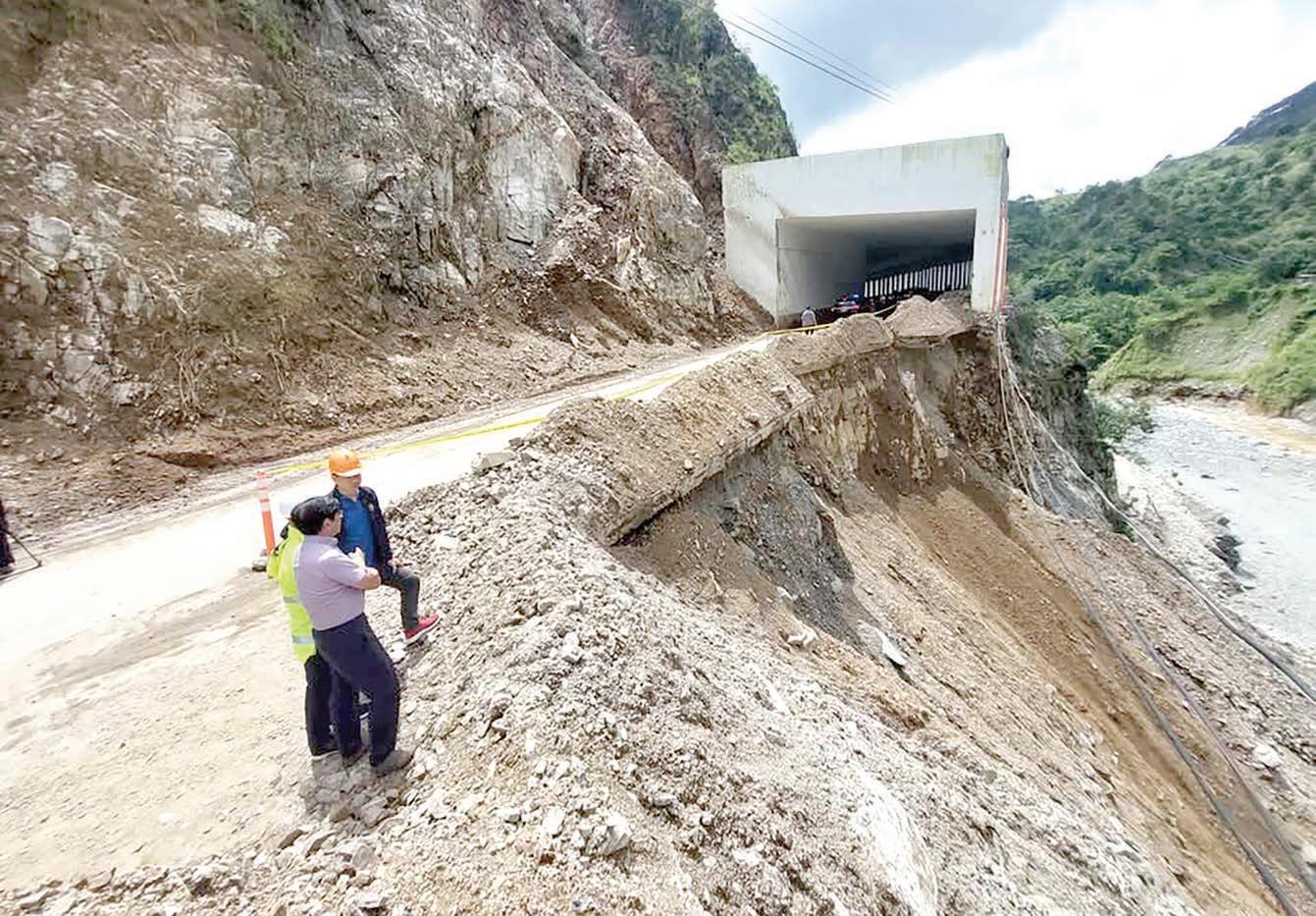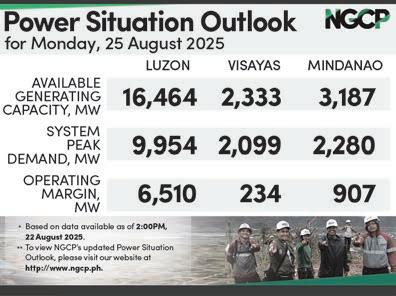






By Cai U. Ordinario @caiordinario
season and stronger consumption could lead to faster economic growth to 5.8 percent in the third quarter, according to the University of Asia and the Pacific (UA&P).
In the latest Market Call report, UA&P said the country’s GDP growth is expected to be buttressed by strong consumption spending boosted by slowing inflation. This expectation is within the 5.5 percent to 6.5 percent projection of the Development Budget Coordination Committee (DBCC). In the first semester, GDP growth averaged 5.4 percent.
“Less destructive typhoons and monsoon rains coupled with belowtarget inflation average of 1.2 percent in Q3 [third quarter] should further boost consumer spending, even as infrastructure works accelerate,” Market Call stated. The positive outlook for the farm sector in the third quarter was evident in the sector’s second quarter performance based on data from the

By Andrea E. San Juan @andreasanjuan
THE “dim” outlook for Philippine shipments bound for the United States this year may also affect the country’s overall export performance as Philippine exporters are unsure if they can easily penetrate other markets aside from the US, according to the head of Philippine Exporters Confederation Inc. (Philexport).
“The dim outlook is for the US market, but it can affect the total,” Philexport President Sergio R. Ortiz-Luis Jr. told reporters on the sidelines of the recent
Philippine Chamber of Commerce and Industry’s (PCCI) 2nd General Membership Meeting in Makati City.
While “diversification” of export markets is the ultimate strategy that the government eyes to cushion the impact of the reciprocal tariff imposed by Washington, the Philexport chief said this strategy is “Easier said than done” because, “For the last 20 years, we’ve been trying to diversify. But there’s no fund. There’s no support. Unlike our neighbors who do research and development, who do research on policies.”


BBy Marilou Guieb
AGUIO
CITY—President Ferdinand
Marcos Jr. on Sunday expressed disappointment as he inspected the rockshed at Camp 6 in Tuba, Benguet, which has been deemed unstable mere months after it was completed. He said that this is about the fifth inspection he has made and in exasperation he blurted out, “ It’s always the same.”
The 152-meter rockshed is a P264-million tunnel of prefabricated material which was built to serve as a catchment for debris falling from the mountain slope and as part of the initiative to eventually make the famous Kennon Road an all-weather road.
While the rockshed itself is intact, the series of typhoons and the ensuing habagat in July caused a massive landslide which eroded an existing slope protection of the road near and partly beneath where the rockshed stands—a situation which may cause its collapse.
Marcos said the eroded part of the road holding the tunnel that was washed away is the most important part, and blamed it on the design of the
slope protection which was built too thin and too small. Because of this, he said, the water seeped in and when the water was too heavy, it washed away everything. “This was all destroyed because of the land/rock slide here,” he said.
“Now the project cost us P260 million, more or less. That money spent for this project had no effect whatsoever as to protect the slope. Parang walang ginawa. Pareho lang kung wala sila tinayo, wala silang ginawang slope protection, wala silang ginawang riprap, ganun din ang nangyari [It’s as if nothing was done; they did no slope protection, they did no riprap, the outcome is the same],” he said.
So this is why, he said, the value of their work is zero, a complete zero.
“And here is the other thing that. I keep talking about—the economic sabotage,” he said.
Marcos claimed that in talking to local officials on the effects on businesses by the closure of the road, he learned that 30 to 35 percent is lost in terms of business. “It is not only the physical damage that we see but the damage to the economy, to people’s livelihood,” he said. He bemoaned that 35 percent then goes to the
pockets of the unscrupulous. “35 percent ng kanilang hanapbuhay para ibulsa ang pera.”
Because of this Marcos said that he is committed to fix the situation. “I will not leave office until fix this,“ he said
The President was further distressed to note that the estimate for fixing the problem will cost the government twice its original P260-million budget. “To correct this it will cause double that. That’s my topof-the-head estimate. This will cost P500 million,” he said. He said the damage and repair needed goes all the way under the tunnel. “So how can you tell me that it is not economic sabotage?” he repeated. Marcos, who also went to inspect the rocknetting projects in Camp 3 in Tuba, Benguet, said that because of the notorious reputation of corruption in such projects, it has been stopped but that these projects continued to be pursued anyway. Other than that, Marcos claimed that coming from the supplier whom he knows, the price of rock net is P3,200 per meter. But the government was charged more than P12,000. “ So that’s times four or 75 percent kickback that we are facing,” he said. Engr. Arnold Dacwag of the Planning Division of the Department of Public Works and Highways in the Cordillera (DPWH-CAR) softened the pronouncement of the President that what may be needed to repair the eroded portion of the road would be an estimate of P100 million which they will request from the national DRRM calamity fund. The eroded portion holding the rockshed stretches some 60 meters and was an existing slope protection built sometime in 2000. “That’s been 15 years,“ he said, implying that time, and weather conditions could have caused the disaster. The recent habagat
Continued from A10
Under the law, Tieza extends fiscal and nonfiscal incentives for new domestic market enterprises such as income-tax holiday for four to six years, depending on the location; enhanced deductions for five years after ITH; and duty-free importation on capital equipment, raw materials. spare parts or accessories up to 12 years. Other tax and non-tax incentives are also available to export enterprises and expansion projects.
To ease investors’ registration experience, the Tieza chief said: “We’ve streamlined the registration process, significantly reducing the turnaround time for applications to 20 working days upon complete submission of documents and information.”
Tieza has also issued a special processing timeline for the registration of Micro and Small tourism enterprises and have make registration fees competitive with other IPAs, to encourage more tourism investors to apply with the government firm.
Investment briefings
WE work closely with tourism stakeholders like the Philippine Hotel Owners Association [PHOA] and business chambers and regularly conduct business briefings and local investment roadshows all over the country to raise awareness regarding the government incentives that may be availed of by potentional tourism investors,” he added.
At PHOA’s recent Philippine Hotel Connect 2025, Lapid underscored Tieza’s “unique and strategic role, i.e., building the physical catalyst that allows hotels to thrive, communities to grow, and visitors to keep coming back [such as] water and drainage systems, access facilities to boardwalks, convention centers, water and sewerage systems, and utilities.”
As such, he encouraged the conference participants to look at the government firm as “your ally.” Tieza recently collected nearly P3.9 billion in travel taxes in the first half of the year. The firm uses said taxes to implement vital infrastructure projects. (See, “Tieza’s travel tax collection exceeds pre-pandemic level,” in the BusinessMirror, July 30, 2025.)
By Samuel P. Medenilla @sam_medenilla
MALACAÑANG said the Konektadong Pinoy Bill, which is expected to make internet services cheaper but is widely opposed by the big telecommunication (telco) firms, has lapsed into law.
Palace Press Office Press Officer Claire Castro made the announcement on Sunday, days after telcos announced they submitted their position paper on the new law to the Office of the President.
“Konektadong Pinoy Bill is now a law,” she said.
Under the country’s legislative process, the President may sign, veto or a allow
Continued from A10
he said. “It’s an investment in our farmers—the lifeblood of our country—whose calloused hands bring
Continued from A1
Philippine Statistics Authority (PSA). In the second quarter, the agricul-
a enrolled bill of Congress to “lapse into law” by not signing it within 30 days from receipt in his or her office.
Last week, the Presidential Communications Office (PCO) undersecretary confirmed that President Ferdinand Marcos Jr. was already studying the bill to determine if he will veto the law or not as requested by telcos.
This after telcos said they have submitted their position paper on the measure to the Office of the President.
Members of the Philippine Association of Private Telecommunications (Paptelco) as well as the Federation of International Cable TV and Telecommunications Association of the Philippines (Fictap), and the CitizenWatch Philippines have
food to our tables.”
Villafuerte also noted that the province is working to ensure the facility is completed by December, so that farmers can start benefiting from it early next year. Meanwhile, Laurel said the Camarines Sur facility
ture, fishery, and forestry (AFF) posted a growth of 1.7 percent and contributed positively to GDP, accounting for 0.51 percentage points of the 5.5 percent posted in the second quarter. Department of Economy, Plan-

opposed the bill since the claim it contained provisions, which are unconstitutional, will cause regulatory imbalance and expose the public to cybersecurity risks.
The Department of Information and Communication Technology (DICT) and the Department of Economy, Planning, and Development (DEPDev) backed the implementation of the new law, saying it will help increase market competition in the country’s telecommunications sector.
The law, which is part of the priority legislative measures of the Marcos administration, aims to simplify the entry of service providers into the
is part of a nationwide network of mega and modular cold storage complexes that the DA is rolling out.
Other sites with cold storage facilities set to open starting next year include Taguig City, Cabanatuan City, and the provinces of Occidental
ning, and Development (DepDev) Secretary Arsenio M. Balisacan earlier said the agriculture sector rebounded to post a growth of 7 percent from the 2.2 percent recorded in the first quarter and the 2.3-percent contraction in the same period last year.
“The government is intensifying the rollout of programs and projects that bring quality public services—especially in education, health, food security, and digital and physical connectivity—closer to the people,” Balisacan earlier said.
Despite the slowdown in inflation to 0.9 percent, UA&P said seasonallyadjusted inflation remained steady at a growth of 0.2 percent.
UA&P said they expect inflation to average 1.6 percent in 2025. This remains below the government’s 2 to 4 percent inflation target.
Rate cuts favored THE low inflation environment, UA&P said, should give the Bangko Sentral ng Pilipinas (BSP) Monetary Board more reason to continue reducing interest rates.
UA&P said it will help if the BSP will consider a larger reduction in policy rates of 50 basis points instead of the 25 basis points it has implemented in the past two meetings when it reduced policy rates.
“Residential construction will remain subdued due to the elevated policy and interest rates, unless BSP increases its rate cut to 50 bps in its August 28th meeting from the widely expected 25 bps rate
market to make internet services cheaper for consumers.
Among its salient features is it exempts transmission providers from securing congressional franchise and a Certificate of Public Convenience and Necessity.
It will also reduce the regulatory duties of the National Telecommunications Commissions (NTC), and remove the vetting for new telecommunication players.
Castro earlier said that the government will get the inputs of the private sector to try to remedy some of their concerns on the new law through its implementing rules and regulations (IRR).
Mindoro and Isabela. In addition, over 100 modular cold storage units will be deployed to various farming communities across the country.
“This is how we build a food-secure and farmer-empowered Philippines,” Laurel said. Ada Pelonia
cut,” Market Call stated. “The USDPHP rate will move either way depending on the extent of policy rate cuts of BSP and the Fed.”
Based on end-month figures from the BSP, the US dollar-Philippine peso rate settled at P57.31. This meant the peso depreciated 1.3 percent in July from the 1.8 percent in June 2025. The peso is expected to continue depreciating to the P57.5 to the US dollar level toward the last quarter of the year.
“We expect some pressure to weaken the USDPHP in the coming months, especially if BSP decides to cut 50 bps or higher in total for its August and December meetings,” UA&P said.
The BSP earlier said a rate cut is on the table in August as the dust cloud created by the imposition of higher tariffs by the United States has begun to clear. (See: https://businessmirror.com.ph/2025/07/30/ august-rate-cut-seen-as-tariffchaos-clears/).
BSP Governor Eli M. Remolona Jr. told reporters, however, that Monetary Authorities are still looking at a reduction of 50 basis points in interest rates in the second semester of 2025, believed to be delivered in two separate meetings of the Monetary Board.
Only a “very unlikely event” could merit a third cut that could bring a 75-basis-point reduction in policy rates this year. Remolona said this “drastic decline” in economic growth is not only based on quarterly growth but also the country’s growth prospects.
countries. It depends if we’re competitive.”
The head of the umbrella organization of Philippine exporters pointed out anew that local exporters are not receiving support for promotions and exhibitions.
“If they join, our booths will look pathetic. So unless the government seriously says we will support exports, and really puts money into it, not lip service...I don’t see a [diversification] trend,” added Ortiz-Luis.
Next to the United States, the second largest export market of the Philippines is the Greater China, which includes Hong Kong and People’s Republic of China.
Asked if it’s possible for Philippine exporters to diversify their shipments to the Greater China, Ortiz-Luis said: “The problem is we’re fighting China. That’s why their tourism is gone.”
On the possibility of diversifying to the Japan market, he said: “But Japan can agree with other
Meanwhile, asked on how Philippine exporters are coping right now, the Philexport chief told the BusinessMirror that those who are exporting to the United States are “mostly worried,” adding, “but if not [exporting to the US], it’s the same.”
In April, Ortiz-Luis said Philexport conducted a survey and asked exporters how they are responding to the reciprocal tariff imposed by Washington.
He said 90 percent of exporters answered “the same,” meaning they are in a business-as-usual mode, while 10 percent said their buyers are cautious.
Ortiz-Luis revealed that some exporters who belong to the 10 percent of the respondents in the survey have opted not to ship due to the US tariff policy.
“As I said, 10 percent of the buyers are cautious also and they’re holding orders. So expansions are held...Those 10 percent are the ones whose buyers mostly stopped,” he also noted.
Latest Philippine Statistics
have yet to be approved by the commission, Juan said the five-man agency will have to complete its evaluation and decide soonest.
The power firms, which have long proposed automatic approval for all PSAs that have undergone the CSP process, are looking forward to this positive movement in this new commission.
“We believe in the CSP process and that the winning bidder’s price should be respected as it is the result of an open and competitive bidding. As long as it is compliant with the CSP guidelines then it must be respected,” said Atty. Anne EstorcoMontelibano, executive director of the Independent Power Producers Association (PIPPA).
To former Energy Undersecretary Atty. Jay Layug, who leads the Developers of Renewable Energy for AdvanceMent, Inc. (DREAM), the proposed amendment gives investors more confidence in the integrity of the bidding process conducted by the pertinent DU.
“As long as the DU complied strictly with its bidding guidelines, ERC and DOE requirements ensuring a transparent, open and fair bidding, then we fully support the move of ERC to uphold the results of the CSP process without subjecting the winning bid to the same proc ss under the ERC,” Layug said.
Meralco PowerGen Corp. (MGen), the power generation arm of Meralco, said that from the perspective of power generators, the competitive nature of the CSP already ensures that participants have submitted their best offers upfront.
“We fully support the proposal. The results of a CSP, once compliant with all the necessary documentation and submissions, should already be considered final and executory. This gives credibility to the process which will give confidence to investors,” said MGen President Emmanuel Rubio.
ACEN Corp. President Eric Francia pointed out that respecting a credible and compliant CSP creates a level playing field where fairness and predictability drive growth. “It attracts more investment, stimulates stronger competition, and results in better offers for consumers—all while keeping investors engaged and motivated,” he said. The CSP is meant to secure longterm PSAs, aiming to find the lowest-cost power sources to meet its customers’ needs. It is designed to ensure transparency and fairness in the selection of power suppliers. The proposed changes in the competitive bidding will soon undergo a public consultation. “We will present this, finalize this, and approve this,” Juan said.
Authority (PSA) data showed the United States remains to be the Philippines’ top export market. Shipments to the US in the first half of 2025 reached $6.59 billion or 16 percent of the country’s exports. The Philippines’s second largest export market is Hong Kong with shipments of $5.71 billion. This was followed by Japan, with Philippine exports to this country reaching $5.81 billion.
Exports to the US in the first half of the year grew 13.2 percent while shipments bound for Hong Kong and Japan climbed by 9 percent and 15 percent, respectively.
Despite the dim outlook due to the US tariff policy, Ortiz-Luis said the Philippine exporters are still hoping to hit the $110- billion exports target for goods and services this year.
As of June 2025, Philippine merchandise exports are valued at $41.24 billion, or 13.2 percent higher than the $36.44 billion in the same six-month period in 2024. The 19-percent country reciprocal tariff imposed by Washington on Philippine goods started to take effect last August 7, 2025.
www.businessmirror.com.ph
By Jovee Marie N. dela Cruz @joveemarie

LAWMAKERS on Sunday strongly supported the extradition of Apollo Quiboloy to the United States, stressing that the Philippines must not provide safe haven to individuals accused of trafficking and exploiting women and children.
Deputy Speaker Jefferson Khonghun said trafficking is a transnational crime that destroys lives and preys on the most vulnerable.
“Trafficking is one of the most heinous crimes. It destroys lives and preys on the weakest among us. No one should ever escape accountability, especially when it involves the abuse of women and children,” Khonghun, who represents Zambales, said. He underscored that extradition is both a legal duty under international treaties and a moral obligation, citing the United Nations Convention against Transnational Organized Crime, or Palermo Convention, which the Philippines ratified in 2002.
Quiboloy, the self-proclaimed “Appointed Son of God” and leader of the Kingdom of Jesus Christ cult, is wanted in the US on charges of sex trafficking, bulk cash smuggling, and immigration fraud.
Manila Rep. Bienvenido Abante Jr., chairman of the House Committee on Human Rights, also supported Quiboloy’s extradition, saying international cooperation is crucial in the fight against trafficking.
“The war against the sexual exploitation and trafficking of women and children is a global one,” said Abante. “Countries need to work together to stop it. International cooperation, including extradition, should be utilized for us to make inroads against this evil,” he added.
The veteran legislator pointed out that “our responsibility does not end at our borders. When the fight is against a crime that violates the most vulnerable amongst us, there should be no safe havens.”
Meanwhile, Party-list Rep. Leila de Lima
“This is not a political issue. This is not about who is being accused. When the crime is as grave as trafficking, there are no safe territories, and no one should be shielded,” he declared. He said extradition is both a legal duty and a moral stand.
See “Quiboloy,” A4

TBy Joel R. San Juan @jrsanjuan1573
HE Court of Tax Appeals (CTA) has enjoined the Bureau of Internal Revenue from enforcing the 1991 Marcos estate tax assessment against the P8.6 billion worth of shares in San Miguel Corp. (SMC) registered under the name of the late businessman Eduardo Cojuangco Jr.
In a 59-page decision written by Associate Justice Lanee Cui-David, the CTA’s First Division held that the said 16,276.879 SMC shares are exclusive properties of the late businessman Eduardo “Danding” Cojuangco Jr. and several corporations, and are not part of the 1991 estate tax assessment levied against the Marcos estate that has been affirmed with finality and deemed collectible by the Supreme Court (SC).
The 1991 estate tax assessment issued by the Bureau of Internal Revenue (BIR) against the estate of the late President Ferdinand Marcos Sr. reflected a total estate tax liability of P23.29 billion.
The assessment also indicated a gross
estate valued P36.17 billion, which included SMC shares of stocks in the total amount of P8,610,464,000.
Cojuangco has been tagged as one of cronies used by the Marcoses as dummies to amass ill-gotten wealth during their reign.
Following the ouster of Marcos Sr. in 1986, the Philippine government has been engaged in numerous legal battles to sequester the Marcoses’ ill-gotten wealth.
“Respondent’s unfounded persistence in pursuing collection against the Cojuangco SMC shares, despite their exclusion from the decedent’s estate, shows arbitrariness, capriciousness, and whimsicality, amounting to grave abuse of discretion,” the court said.
The CTA stressed that it was constrained to intervene as BIR’s actions place individuals who are not parties to the tax assessment, such as Cojuangco and other shareholders, at risk of being held liable for a deficiency estate tax owed by a different taxpayer.
It noted that that SMC was not a party to the proceedings leading to the issuance or finality of the 1991 Estate Tax Assessment.
“All told, despite the finality of the 1991
THE Armed Forces (AFP), together with the Australian Defence Force (ADF) and the Royal Canadian Navy (RCN), held a maritime cooperative activity under Exercise Alon on Saturday in the West Philippine Sea, west southwest of El Nido, Palawan, within the Philippines exclusive economic zone at the West Philippine Sea.
Estate Tax Assessment, the Court finds that respondent’s act of distraining ‘various shares of stock’ of SMC was without legal authority and indeed constitutes a grave abuse of discretion.”
The CTA’s decision “reversed and set aside” the November 19, 2024 letter issued by BIR
Commissioner Romeo Lumagui demanding the enforcement of the 1991 Estate Tax Assessment against the Marcos estate through “distraint of levy” which included the said SMC shares.
The tax appellate court held that the BIR is prohibited from enforcing the estate tax assessment against the subject shares in SMC.
“Collection must be made directed at the delinquent taxpayer; third parties who are not subject to the assessment should not be made to bear its burden,” the CTA explained.
It can be recalled that in 2011, the SC affirmed the ruling issued by the Sandiganbayan which declared that the block of shares in SMC is the exclusive property of Cojuangco, et al.
The SC declared that the government failed to present sufficient evidence to prove
its allegations that Cojuangco used the coconut levy funds, which are public funds, to acquire 20 percent of SMC shares and that he used his positions in United Coconut Planters Bank (UCPB)
“Again,
Comelec hopes to start ballot printing on Sept. 8
By Justine Xyrah Garcia

The exercise featured helicopter cross-deck landings, personnel transfers via MH-60 “Seahawk” choppers and rigid-hulled inflatable boats (RHIBs), as well as ship-to-ship interoperability drills.
Participating warships included the Navy’s (PN) flagship BRP Jose Rizal (FF-150), the Royal Australian Navy’s HMAS Brisbane (DDG-41), and the Royal Canadian Navy’s HMCS Ville de Québec (FFH-332).

The AFP said the engagement “reflects a shared resolve to uphold a rules-based international order in the Indo-Pacific and reinforces the commitment of the Philippines, Australia, and Canada to promote freedom of navigation, regional stability, and collective maritime security.”
PHL-Australia defense ties
THE joint sail comes a day after the

Second Philippines-Australia Defense Ministers’ Meeting in Manila, where Defense Secretary Gilberto Teodoro Jr. and Australian Deputy Prime Minister and Minister of Defense Richard Marles reaffirmed defense cooperation as a vital pillar of the Philippines–Australia strategic partnership.
THE Commission on Elections (Comelec) is eyeing September 8 as the start of the ballot printing for the first parliamentary polls in the Bangsamoro Autonomous Region in Muslim Mindanao (BARMM).
In a recent media interview, Comelec Chairman George Erwin M. Garcia said that the ballot faces are expected to be

affected once the proposed redistricting bill—which would transfer several towns to new districts in Bangsamoro—is enacted into law.
“Based on what the [Project Management Office] said, this [printing] may happen on September 8 so we can better study and review the law in its entirety...It won’t be difficult for the Comelec since it only















































































A4
Monday, August 25, 2025
By Jovee Marie N. dela Cruz @joveemarie

AMEMBER of the House of Representatives has expressed opposition to Sen. Panfilo Lacson’s proposal for the Senate to adopt in toto the P6.3-trillion 2026 National Expenditure Program (NEP), warning that such a move would undermine Congress’ constitutional mandate to scrutinize the national budget.
Party-list Rep. Leila de Lima of Mamamayang Liberal (ML) said that Congress holds the “power of the purse,” and bypassing its duty to examine the proposed budget
would amount to abandoning its constitutional responsibility to the Filipino people.
“We understand where Senator Ping is coming from, given
the magnitude of corruption in the national budget. I cannot, of course, speak for the Senate, and I’m simply airing here my own views as a member of the House of Representatives,” de Lima said.
“For example, if his suggestion were implemented, what if in the future there is a corrupt President, and Congress and the Senate merely follow his lead? That could be used as an excuse—it was done before, so why not do it again?” she said.
The House member instead urged a more rigorous review of the NEP, calling for accountability at every stage.
“What we should all do is to seriously and thoroughly scrutinize the National Budget and hold those involved in anomalous projects accountable. Let’s safeguard our nation’s coffers—from the budget proposal to the deliberations and passage in Congress, including the deliberations at the BiCam level,
up to the implementation by government agencies,” she said.
“Hold the corrupt accountable, not let them off the hook. Fix or close the loopholes in the law, not cover up for the lawmakers involved. Correct the process, not abandon it—always for the benefit of the Filipino people,” de Lima added.
Lacson, in a radio interview, had suggested that the Senate adopt the NEP wholesale “for a change” as an experiment, placing the burden of accountability for the budget’s execution on the Executive branch.
He maintained that the proposed items in the NEP had been studied carefully by the implementing agencies and that such an arrangement would allow Congress to focus on monitoring project implementation.
“This will be a one-year experiment. If it fails, we go back to the realignment,” Lacson said.
THE Department of Migrant Workers (DMW) is now working on a comprehensive data sharing agreement with the Statistics Authority (PSA), which will result in better government policies for Filipinos working abroad. Under the proposed arrangement, DMW will help PSA in collecting data sets on Gross National Income, National Migration Survey, and Survey on Overseas Filipinos.
For its part, PSA will provide DMW access to data under the Philippine Identification System (Philsys) through the DMW’s eregistration system.
Migrant Worker Undersecretary Dominique Rubia-Tutay said they discussed the proposed partnership in a meeting with PSA on Friday.
During the meeting, she raised the possibility for PSA to come up with more OFW-related statistics.
“We also hope that PSA will
generate deseggregated data sets especially on the demographics of land-based and sea-based OFWs, to enable a more comprehensive assessment of their situations and needs,” she said.
Aside from Tutay, other DMW officials, who were present in the meeting were Assistant Secretary Levinson C. Alcantara and Director Grace Teodosio.
The PSA was represented by Deputy National Statistician Rosalinda P. Bautista and Deputy
National Statistician Divina Gracia L. del Prado.
DMW and PSA currently have partnerships in the promotion of PhilSys enrollment for OFWs and for providing the latter’s services to Filipinos abroad through the former’s Serbisyo Caravans.
DMW said the collaboration is “in line with the directive of President Ferdinand R. Marcos to improve data exchange” among government agencies. Samuel P. Medenilla
Twww.businessmirror.com.ph
By Jonathan L. Mayuga @jonlmayuga

THE Department of Agrarian Reform (DAR) has concluded its mid-year performance assessment to enhance the delivery of farm-to-market roads nationwide.
Through the Project Management Service (PMS) of the department’s Support Services Office (SSO), the DAR convened its Locally Funded CARP Infrastructure Projects Mid-Year Performance Assessment and Planning Workshop for the Second Semester of 2025 on August 19-22.
A total of 58 DAR regional and provincial monitoring and evaluation focal persons, representatives from the SSO, Finance and Management Sector, PARC Secretariat, and the Department of Public Works and Highways (DPWH) participated in the activity, which was managed and facilitated by the PMS-Project Monitoring and Evaluation Division (PMS-PMED).
The four-day workshop gathered CARP Infrastructure Monitoring and Evaluation Focal Persons from DAR Regional and Provincial Offices, representatives from the DAR Central Office, and partner agencies to review accomplishments, address challenges, and recalibrate strategies for the effective implementation of Agrarian Reform Funded (ARF) Farm-to-Market Roads (FMRs) nationwide.
DAR Undersecretary for Support Services Josef Angelo S. Martires said the assessment goes beyond compliance reporting.
“This is not just about numbers and reports. It is about measuring the real impact of these projects on our farmers. By reflecting on
past challenges and successes, we can plan smarter and ensure that every effort counts toward uplifting our agrarian reform beneficiaries,” he said.
As of August 15, DAR has completed 365 farm to market road projects spanning over 307 kilometers, directly benefiting 94,966 agrarian reform beneficiaries (ARBs) nationwide.
“The resources entrusted to us are transformed into sustainable and impactful infrastructure that drives countryside development. Together, we are building not only roads but also pathways to progress for farming communities,” Department of Public Works and Highways (DPWH) Undersecretary Eric A. Ayapana assured DAR during the event.
Agrarian Reform Undersecretary for Finance and Mindanao Affairs Amihilda J. Sangcopan underscored the value of continuous improvement.
“This workshop challenges us to examine what has been achieved, acknowledge the gaps, and push ourselves to find better ways of delivering services. At the heart of all these efforts are our agrarian reform beneficiaries who deserve nothing less than our full commitment,” she said.
PMS Director Von Mark R. Mendoza, whose office spearheaded the workshop, stressed the importance of collaboration.
“This assessment reflects our shared responsibility in ensuring that every kilometer of road built translates to better opportunities for our farmers. The insights we gather here will guide us in making informed decisions and in strengthening our partnership with our field offices and implementing agencies,” he said.
HE Department of Public Works and Highways (DPWH) reported on Sunday that construction of the P20.8billion Samal Island–Davao City Connector (SIDC) Bridge has now reached 41 percent. Public Works Senior Undersecretary Emil Sadain said various substructure works are advancing in parallel, including the construction of ramps and land viaducts on both the Davao and Samal sides, as well as key developments on the marine viaduct and the 275-meter extra-dosed main bridge.
involves around 2.3 to 2.4 million ballots,” Garcia said, mostly in Filipino.
Garcia noted, however, that the measure would likely move several towns to new districts—ultimately affecting the ballot faces, the automated election system (AES), and even the deployment of election materials.
On the Samal side, the steel caisson cofferdam for the navigation pile cap has been lowered and is being prepared for concrete sealing, while on the Davao side, the seal concrete bottom slab has already been installed with preparations underway for
Under BARMM Parliament Bill 351, which was passed on third and final reading last August 19, Sulu’s seven seats will be redistributed or reallocated to the remaining provinces in the autonomous region.
With the new apportionment, Lanao del Sur will now have nine district seats; Maguindanao del Norte and Maguindanao del Sur, five each; Basilan and Tawi-Tawi, four each; Cotabato City, three; and the Special Geographic Area, two.
In a joint statement on Saturday, both sides “underscored the importance of a secure and stable Indo-

caisson lowering, pending final inspection.
Sadain highlighted the completion of seven high pier columns for the land viaducts as a milestone in the project’s vertical construction phase.
The 4.76-kilometer, four-lane bridge broke ground in October 2022 with President Marcos leading the ceremony. Civil works began in May 2024.
Candidates will not be transferred along with their towns and the filing of certificates of candidacy will not be reopened.
Garcia said the Comelec will need at least 12 days to reconfigure the AES and ensure that the consolidated canvassing system, which tallies the aggregate results from all districts, will be able to read all the ballots seamlessly.
He also once again assured that the commission has enough time to make
Pacific region where sovereignty is respected, international law is adhered to, and nations exercise their rights free from coercion.”
They also “expressed serious concern over the situation in the South China Sea, particularly dangerous and coercive actions by China against Philippine vessels,” stressing that the 2016 South China Sea Arbitral Tribunal Award is final and binding on the parties.
Once completed by 2028, the SIDC Bridge will directly connect R. Castillo–Daang Maharlika Junction in Davao City with the Circumferential Road on Samal Island, reducing the current ferry travel time of 55 minutes to about 4.5 minutes.
It is expected to handle 25,000 vehicles daily and boost tourism and commerce in the region.
Lorenz S. Marasigan
these adjustments before the October 13 parliament elections.
“What we will do is increase the number of our personnel, especially at the National Printing Office, where each ballot will be verified,” Garcia said.
“The public should not worry. These issues the Comelec is facing, even if they are not of our own doing, will not affect the October 13 elections. The Bangsamoro polls will definitely push through,” he added.
eration on defense infrastructure development in the Philippines,” projects that will “increase our combined collective capability, enhance interoperability, and strengthen bilateral and multilateral defense cooperation.”
THE leadership of the House of Representatives on Sunday welcomed the reforms introduced by the Department of Migrant Workers (DMW) for overseas Filipino household service workers, assuring that these measures will receive budgetary support from the Marcos administration.
For 2026, Speaker Ferdinand Martin Romualdez said the proposed budget for the DMW amounts to P10.2 billion, including P1.2 billion for the Agarang Kalinga at Saklolo para sa mga OFW na Nangangailangan (Aksyon) Fund and P1.3 billion for the Emergency Repatriation Program.
“These reforms will not only enable our Filipino domestic workers to provide better support for their families but also uplift the dignity of their work in the global labor force,” Romualdez said. Among the key reforms is the increase in the monthly minimum wage of Filipino domestic helpers from US$400 to US$500, which will take effect 60 days after the issuance of the directive and will be incorporated into all DMW-processed contracts.
Stricter housing standards for recruitment agencies and an enhanced whitelisting policy will likewise be enforced to ensure only compliant and ethical agencies are allowed to deploy domestic helpers abroad.
“Like other OFWs toiling in far-away lands, Filipino domestic workers perform work of equal value that deserves fair compensation. These reforms are not only to ensure that they can send more to their families back home but also to promote the dignity of work as members of the labor force,” Romualdez said.
He underscored that these reforms, backed by budgetary support under the Marcos administration, demonstrate the President’s clear priority for the welfare of OFWs.
The Speaker also noted that the Overseas Workers Welfare Administration (Owwa) is set to receive P3.45 billion in 2026, with P2.42 billion earmarked for social protection and welfare programs for OFWs and their families.
Continued from A3 of Mamamayang Liberal (ML), a former Justice secretary, explained that while local cases are a factor, extradition remains possible even if charges are pending in the Philippines.
Teodoro and Marles said they “resolved to continue working together to uphold international law and support regional maritime security,” while committing to deepen collaboration under existing agreements such as the Status of Visiting Forces Agreement (Sovfa) and the Mutual Logistic Support Arrangement (MLSA).
They also welcomed “new coop -
Exercise Alon has emerged as the flagship bilateral drill between Manila and Canberra, complementing the Philippines’ debut participation in Australia’s large-scale Talisman Sabre 2025 earlier this year. For Australia, it is the largest overseas military exercise in 2025, reflecting Canberra’s commitment to building defense partnerships in the region.
The defense officials also vowed to meet again next year for the Third Philippines and Australia Defense Ministers Meeting as both countries look to further deepen defense ties. PNA with Rex Anthony Naval
Additional safeguards announced by the DMW include annual DMW-funded medical checkups for domestic workers, a mandatory “know your employer” video call before contract signing, and a digital monitoring system dubbed “Kamusta Kabayan” to allow proactive welfare checks.
Continued from A3
“We in the House of Representatives will make sure that programs supporting OFWs and their families are given adequate funding under the administration of President Marcos, who has consistently shown genuine care for our migrant workers. This is our duty under Bagong Pilipinas,” Romualdez said. He assured OFWs that the government will remain a steadfast partner in defending their rights and helping them achieve their aspirations. Jovee Marie N. dela Cruz
“It is the discretion of the requested state, in this case the Philippines, to temporarily surrender or postpone proceedings. The option is with the Executive [branch], through the DOJ, with clearance from the Chief Executive, and subject to conditions agreed upon with the US State Department,” she said. She noted that the Department of Foreign Affairs must first determine if the case falls under the extradition treaty before the DOJ conducts its evaluation and brings the matter to court.

DBy Ada Pelonia @adapelonia
ESPITE the increase in the country’s rice output in the first half, an international agency said this may not be enough to fill the anticipated demand during the Philippines’ import ban, which will kick off on September 1.
The United States Department of Agriculture (USDA) said the Philippines imported over
750,000 metric tons (MT) of rice from mid-September to midNovember in the last two years
SCORCHING temperatures are hurting the European Union’s corn crops, putting the bloc on track for its largest imports in three seasons.
Temperatures in the week to August 16 rose as much as 9 degrees Celcius above normal in northern Spain and southern France, according to the US Department of Agriculture. The heat has dimmed prospects for both quality and yields.
The share of French corn rated in good to excellent condition fell to 62 percent in the week to August 18, crops office FranceAgriMer said Friday, well below last year’s figure. Dry weather is also hurting crops in Bulgaria, where corn and sunflower yields may drop to their lowest in decades.
Buyers are likely to offset any potential crop shortfalls with cheap and plentiful supplies from other regions. Expectations of bumper harvests in Brazil and the US have weighed on prices, sending Chicago corn futures to an almost 12-month low earlier in August.
Paris corn futures rose as much as 0.8 percent to the highest in more than a week on Friday, before paring gains.
Corn from both Brazil and the US is “pricing very competitively on the global market, which is encouraging import demand,” said Matt Darragh, a grains and oilseed analyst at Kpler. “Corn production in the EU is coming under a bit of stress, so this is likely to support corn imports too.”
The EU is expected to import 21 million tons of corn in the 2025-26 season, according to a forecast by the International Grains Council. That would make the bloc the world’s second-largest buyer for a second straight year, as China—typically a strong purchaser of the feed grain— faces weaker demand.
European crop harvests are expected to accelerate heading into the fall, with cooler, wetter weather forecast in the coming days.
“Rain in south central areas should continue to replenish moisture for late growth of corn and sunflowers,” said Vaisala meteorologist Donald Keeney. “However, dryness will continue across UK, northern Germany, southern Ro -
mania, Bulgaria and Spain.”
Indonesia’s modern farms
INDONESIA’S state agriculture firm Agrinas Pangan Nusantara (Persero) is proposing to turn idle land owned by the army into modern farms at a cost of 870 billion rupiah ($53 million) in a bid to jumpstart the national food estate program.
It plans to use the funds to develop the first state-owned modern farm, spanning 12,000 hectares in Baturaja, South Sumatra, said outgoing President Director Joao Angelo de Sousa Mota in an interview on Thursday. Agrinas has yet to receive funding approval from its main shareholder Danantara Indonesia, Mota said.
The initiative could revive the government’s stalled food estate program and support President Prabowo Subianto’s goal of achieving food self-sufficiency in the nation where 280 million people consume around 30 million tons of rice annually.
Still, bureaucratic hurdles may pose a challenge to its execution, which, according to Mota, contributed to his decision to resign after just six months leading the company. A shareholders meeting is scheduled for next week to decide on his resignation.
Agrinas’s proposal follows Prabowo’s instruction to his ministers, including the Defense Minister, to coordinate efforts to develop food security regions in provinces including South Papua, Central Kalimantan, South Sumatra and South Kalimantan.
Mota said the move would help the company avoid land acquisition issues that have plagued large infrastructure projects in Indonesia. If successful, the Baturaja farm could serve as a model for replication in other locations, including Kalimantan. Agrinas has a target of managing over 400,000 hectares of rice fields this year, he added.
The latest initiative echoes Indonesia’s past efforts to achieve food self-sufficiency, including a failed attempt in the 1990s to convert one million hectares of peat land into rice fields in Kalimantan.
Bloomberg News
and that import demand during the import ban is pegged at the same level this year.
“While domestic rice production in the first half of 2025 increased by over 6 percent compared to last year, this growth may not fully offset the anticipated demand during the import ban,” the USDA said.
Figures from the Philippine Statistics Authority (PSA) showed that palay output in January to June grew by 6.41 percent to a record 9.077 million metric tons (MMT) from the 8.53 MMT posted in the same period last year.
The last time unmilled rice production breached the 9-MMT mark
in the first half of the year was in 2023, when it reached 9.026 MMT.
“Based on estimated consumption and 2025 [second] semester production, FAS Manila estimates import demand during the period of the temporary ban at similar levels to the last two marketing years,” the USDA said.
Meanwhile, the country’s wet cropping season harvest is expected to begin by mid-August and will peak between September and October.
The international agency said this will provide supply that may be purchased by the National Food Authority (NFA), traders, and millers, contingent on storage capacity
and market dynamics.
“With the rice import ban in effect, this harvest becomes even more critical in addressing domestic supply needs, as reduced import availability may intensify pressure on local production to meet demand and stabilize prices.”
President Ferdinand R. Marcos Jr. ordered the temporary ban on foreign shipments of the staple grain for 60 days as part of the government’s efforts to prop up farmgate prices of palay, which dropped to as low as P8 per kilo in some areas.
Industry sources cited the unabated entry of imported rice, whose international quotations
have been slashed since worldleading rice exporter India lifted its export ban on non-basmati rice, as the reason behind the steady decline in farmgate prices of unmilled rice.
Based on government data, 2.67 MMT of rice has entered the country as of August 14.
The country’s rice production fell by nearly a million tons to 19.09 million metric tons (MMT) last year, from a record-high 20.06 MMT recorded in 2023 due to El Niño. Because of the supply shortfall caused by the drought, the country’s rice imports reached an alltime high of 4.8 MMT last year.
APROJECTED bumper harvest and lackluster demand in key markets are pulling down global prices of wheat and corn, according to an international research firm.
BMI, a unit of Fitch Solutions, recently reported that an expected record corn harvest in the United States for the 2025/26 season placed downward pressure on the commodity’s quotations throughout the year.
Citing a report from the US Department of Agriculture (USDA), BMI noted the US harvest forecast of 425.3 million metric tons (MMT) from its initial projection of 401.9 MMT, which “reinforces the narrative of an ample global stockpile.”
“Although prices have partially recovered amid ongoing weather concerns and some uncertainty around the USDA’s forecasts, we note that robust US output expectations continue to signal sustained price weakness through the remainder of 2025 and into 2026.”
BMI also noted that an abundant supply from the leading wheat powerhouse European Union, took a toll on prices of the grain.
“While US corn crop expectations continue to weigh on global corn prices, wheat prices are facing additional pressure from rising

European output.”
USDA estimates raised EU wheat production to 138.3 MMT from 137.3 MMT, while France’s farm ministry increased its outlook for soft wheat to 33.1 MMT from 32.6 MMT.
“We now expect a year-on-year increase in French output of 26.9 percent, which is weighing on both Chicago and European wheat prices,” BMI said.
It noted that the completion of key harvests in Europe and the near-complete US winter wheat harvest, alongside the ongoing spring wheat harvest, suggest a robust supply and will “continue to cap wheat prices” for the rest of the year.
The Philippines imports part of
its corn requirement to meet the growing demand for animal feed and industrial use.
Based on government data, the average farmgate price of yellow corn, typically used for animal feeds, settled at P14.96 per kilo in June, from P18.6 per kilo in the same period last year.
For white corn, the average price stood at P13.65 per kilo in the reference month, from P21.62 per kilo last year.
‘Weak demand’
MEANWHILE , the research firm also noted that tepid demand in key markets, such as China, also affects global quotations of the grains.
“In addition to harvest
pressures, weak demand in key markets is further suppressing global prices.”
In particular, the firm said China’s customs data showed a “steep decline” in import demand through 2025.
BMI said China’s cumulative corn shipments from January to July indicated an annual decline of 93.1 percent, while wheat imports fell by 76.5 percent in the same period.
“The overall slowdown in Chinese imports remains a key factor weighing on global prices.” It added that ongoing duties levied on US farm products, including wheat and corn, have “effectively halted” trade between the two nations.
Despite this, the BMI said it expects Chinese grain demand to recover from these lows, which could provide an upside risk to prices.
The firm cited the USDA’s forecast of a 150 percent year-on-year increase in China’s corn imports for the 2025/26 season and a 43.9 percent annual rise in wheat imports.
“[This is] driven by a substantial production deficit and China’s reluctance to draw down domestic stockpiles, which will provide a base of support for prices.” Ada Pelonia
SBy Butch Fernandez @butchfBM

ENATOR Francis Pangilinan is asking President Ferdinand Marcos Jr. to certify as urgent a bill institutionalizing the extension services provided by the government to farmers and fisherfolk to ensure rural development and uplift the living conditions of agricultural workers.
The senator, who chairs the Senate Committee on Agriculture, Food, and Agrarian Reform, revealed plans to ask the President to prioritize the passage of Senate Bill 1182, or the Agriculture and Fisheries Extension Act of 2025, which he filed last August 13.
In his privilege speech last week about the state of the country’s agricultural sector, the senator underscored the need for agricultural extension services at the provincial and municipal levels, as well as the strengthening of agricultural cooperatives.
Uumpisahan na natin ang mga hearing tungkol dito at hinihiling natin sa pangulo na i-certify itong mga bills bilang urgent—extension service at pagpapalakas ng agriculture coops under the DA [Department of Agriculture].”
Pangilinan has personal awareness of the systematic failure to provide extension services to farmers and fisherfolk.
As a farmer-CEO who has been
By Jonathan L. Mayuga @jonlmayuga

AGRARIAN reform beneficiary organizations (ARBOs) in Bohol and Cebu have secured exclusive contracts with the Department of Social Welfare and Development (DSWD) in the two provinces for the supply of agricultural products and by-products under the DSWD’s Supplementary Feeding Program (SFP). The DAR said thousands of children enrolled in the program are set to benefit from the program from the DARDSWD initiative. In a ceremonial signing held in Cebu City, the Bohol Bayanihan (Bangon Yanong Igsoon Haligi ka sa Nasud)
Multipurpose Cooperative and the Carcar Communities and Farmers Multipurpose Cooperative formalized their partnership with the DSWD through the Enhanced Partnership Against Hunger and Poverty (EPAHP) and the SFP. The Bohol Bayanihan Multipurpose Cooperative secured purchase orders worth
P1,354,320, while the Carcar Communities and Farmers Multipurpose Cooperative obtained an amount of P3,109,590. Both are now official suppliers for SFP Cycle 15, ensuring that the government feeding programs are powered by locally sourced, fresh, and nutritious produce. “This is more than just
running his own farm in Alfonso, Cavite for more than a decade, the senator said the nearest DA regional office to him was located three hours away in Lipa, Batangas.
This, he said, resulted in the inability of local farmers and fisherfolk to access critical government services such as loans, financial aid for pesticides and fertilizers, technical training, and many more.
“It shall ensure that public extension services meet the national standards of performance and effectively contribute towards the achievement of the national goals of agriculture and fisheries modernization and sustainable development.”
The measure will likewise mandate the hiring of several agriculture experts—provincial agriculture and fisheries officer (PAFO), assistant PAFO for fisheries development, assistant PAFO for agriculture development, city agriculturist and fisheries officer (CAFO), and municipal agriculture and fisheries officer.
His proposed legislation will create the Philippine Agriculture and Fisheries Extension Agency— replacing the Agricultural Training Institute (ATI)—to serve “as the national apex organization for a unified and efficient agriculture and fisheries extension system of the country.”
a contract signing. It is a commitment to nourish our children while empowering our farmers. By connecting local producers directly to government feeding programs, we create a win-win situation where communities thrive and hunger is addressed at its roots,” said Hazel Hope B. Sacedon, EPAHP focal point person of the Department of Agrarian Reform (DAR) Region 7.
DSWD officials also said such partnerships offer double
benefits: improved nutrition for children and stronger income streams for grassroots food producers.
The DAR said it continues to advance programs that connect farmers to stable markets and integrate them into national development efforts, “ensuring that agricultural communities directly benefit from government initiatives while contributing to food security, nutrition, and inclusive economic growth.”
Monday, August 25, 2025
By Wafaa Shurafa & Adam Geller The Associated Press
GAZA CITY, Gaza Strip—
Not long after Texas surgeon Mohammed Adeel Khaleel arrived at a Gaza City hospital in early August, a 17-year-old was brought in with gunshot wounds to both legs and one hand, sustained when he went to collect food at an aid site.
In the emergency room, Khaleel said he noted the ribs protruding from the teen’s emaciated torso, an indication of severe malnutrition. When doctors at Al-Ahli Hospital stabilized the patient, he raised his heavily bandaged hand and pointed to his empty mouth, Khaleel said.
“The level of hunger is really what’s heartbreaking. You know, we saw malnutrition before, back in November, already starting to happen. But now the level is just, it’s beyond imagination,” Khaleel, a spinal surgeon on his third volunteer stint in Gaza, said in an interview.
On Friday, the Integrated Food Security Phase Classification, or IPC, the leading authority on global hunger crises, said for the first time that parts of Gaza are in famine and warned that it is spreading. For months, U.N. agencies, aid groups and experts had warned that Israel’s blockade and ongoing offensive were pushing the territory to the brink.
In the 24 hours following the famine announcement, eight people in Gaza died of malnutrition-related causes, bringing the overall toll of such deaths during the war to 281, according Gaza’s Health Ministry, which is part of the Hamas-run government and staffed by medical professionals. A US medical nonprofit working in Gaza says one in six children under 5 is affected by acute malnutrition.
Israel rejected the famine announcement, calling it an “outright lie” and pointing to its recent efforts to allow in more food after it eased a complete 2½ month blockade in May. It has accused Hamas of siphoning off aid — allegations disputed by the United Nations, which says Israeli restrictions and a breakdown of law and order make it extremely difficult to deliver food to the most vulnerable.
Khaleel, who spoke to The Associated Press ahead of the announcement, said the evidence of deprivation was already clear.
“Just the degree of weight loss, post-operative complications and starvation that we’re seeing. That wouldn’t surprise me at all if it was called famine,” said Khaleel, who traveled to Gaza as an independent volunteer via the World Health Organization.
At Gaza City’s Shifa Hospital earlier in the week, nutrition director Dr. Mohammad Kuheil led an AP journalist to the bedside of a thin-limbed girl. Aya Sbeteh, 15, was wounded in an airstrike. But her recovery has been set back by weakness from lack of food that her family says has reduced her weight by more than a third.
“All we have are grains like lentils, sometimes,” said her father, Yousef Sbeteh, 44. “Even flour is unaffordable.”
The sick, wounded and young are most vulnerable
ANOTHER patient, Karam Akoumeh, lay with sunken cheeks, his thin skin stretched like plastic wrap across his rib cage. His intestines were seriously damaged when he was shot while going out to collect flour, his family said, compromising his digestive system.
Now he is one of 20 people at Shifa brought in for abdominal wounds and increasingly malnourished because of a shortage of intravenous nutritional supplements, the doctor said.
Akoumeh’s father, Atef, said the lack of supplements compounded the hunger that reduced Karam’s weight from 62 kilograms (136 pounds) to just 35 kilos (77 pounds).
“I checked throughout all Gaza’s hospitals for it (the supplements), but I have not found any,” he said.
Israeli officials have pointed out

that some of those said to have died from malnutrition had preexisting conditions. But doctors and other experts say that is to be expected, as famine first preys on the most vulnerable, including babies and small children.
Doctors and others see signs of hunger everywhere
OUTSIDE the hospital, the shortage of nutrients is equally dire, doctors and civilians say.
“There are no protein sources, only plant-based protein from legumes. Meat and chicken are not available. Dairy products are not available, and fruits are also unavailable,” said Kuheil, the doctor in charge of nutrition at Shifa.
In Gaza City on Friday, Palestinians displaced from elsewhere recounted a desperate search for food.
“We’re starving. We eat once a day. Will we be hungrier than we are now? There’s nothing left,” said Dalia Shamali, whose family has been repeatedly displaced from their home in nearby Shijaiyah.
She said they spent most of their money over the last two years moving from one part of Gaza to another as the Israeli military issued evacuation orders. With Israel allowing more food in recently, the price of flour and other food items has been dropping, but the family still can’t afford them, Shamali said.
Hunger agency says famine is expected to spread IN its announcement Friday, the IPC
said famine in Gaza City is likely to spread across the territory without a ceasefire and a flood of humanitarian aid.
Some of the IPC’s conclusions were echoed in a report by a group that organizes medical missions to Gaza, which described a “catastrophic rise in severe malnutrition” among children and pregnant women.
One of every 6 children in Gaza under 5 is now affected by acute malnutrition, said the report by US nonprofit MedGlobal, based on observations by its staff in four of Gaza’s five governorates. The group warned that all young children in Gaza are at risk of starving without intervention.
Khaleel, the Texas doctor, said he would leave it to others with more expertise to measure exactly what constitutes famine.
But he knows what he saw in three weeks of treating patients in Gaza, most of the time at the hospital in Gaza City. Again and again, medical workers cut open patients’ clothing to treat injuries, revealing a loss of muscle and fat caused by hunger that left skin stretched tight over protruding bones.
“These patients, a number of them that we’re seeing are just exposed ribs, severely skinny extremities,” he said. “And you know that they’re just not getting calories in.”
Geller reported from New York. Associated Press writer Sally Abou AlJoud in Beirut, Lebanon, contributed to this report.
JBy Louise Dewast The Associated Press
OHANNESBURG—On a warm evening in Johannesburg, the news spread like wildfire among sex workers: Within 24 hours, several nonprofit clinics providing free HIV services would be closing as President Donald Trump announced the United States was slashing foreign aid. Some South Africans living with, or at risk of, HIV secured supplies of life-saving drugs just in time. Others did not.
Half a year later, the country with more people living with HIV than any other is struggling to treat its most vulnerable. Over 63,000 people were being treated in the 12 clinics across the nation that shut down. Up to 220,000 people have faced disruption to their daily HIV medication.
South Africa’s government has vowed it won’t let the US withdrawal of about $427 million in support collapse its HIV program, the largest in the world.
Sex workers, among the most vulnerable South Africans as their work is illegal, and transgender people spoke to The Associated Press on condition of anonymity for fear of retaliation from families or commu -
nities. They described a new world of difficulty in obtaining HIV medication or the preventive medicine for people at risk of HIV.
One HIV-positive sex worker and mother of three said she was off medication for almost four months after being turned away from public hospitals, which the government’s health department says should not be happening.
“The only thing that I could think of was my kids, and that I am going to die, and how am I going to explain to my kids that I am sick because of the line of work that I chose?” she said. The 37-year-old said she finally obtained a month’s supply of medication in June from a mobile clinic that was introduced after the funding cuts. She didn’t know what she would do after that.
Another HIV-positive sex worker said she had resorted to illegally buying medication on the black market, where the pills have nearly doubled in price. The US has since issued a limited waiver allowing the resumption of certain life-saving HIV services globally, but the dismantling of much of US foreign aid has created chaos. And for many people affected, harm is already done. Overall, experts warn of hundreds
By Illia Novikov The Associated Press
YIV, Ukraine—Oleksandr
KDonii was one of the leaders of student-led protests for sovereignty and political reform in 1990 that preceded Ukraine’s declaration of independence. He remembers thinking the fight for autonomy would take decades.
Instead, it came much sooner than he ever imagined. When the Soviet Union collapsed, Ukraine quickly declared independence in 1991 and later conducted a referendum backed by more than 90 percent of voters.
“I was preparing myself for prisons and labor camps, and I thought the struggle would last about 20–30 years,” Donii told The Associated Press.
Moscow’s grip endured after independence AS the country marks 34 years since that monumental event Sunday, Donii and others from Ukraine’s first generation of lawmakers and activists describe how despite separation from the Soviet Union, Moscow’s grip endured. Russia used political pressure, social division and the sidelining of pro-Western voices. That eventually paved the way for the full-scale invasion of Ukraine three decades later and Ukraine’s current fight for independence and identity in the face of its aggressive neighbor.
Back in 1990, Donii and other student leaders of a hunger strike were calling not only for breaking away from Moscow but also for renewing the political system at home. Their first proposal was to conduct snap elections for Ukraine’s Parliament, which Donii saw as essential for clearing out the Soviet-era lawmakers still in office. The idea, however, failed to gain broad support even among pro-independence forces.
“Ukraine, having won independence, did not win the removal of the Communist ruling class,” he said. In his view, opportunities that were within reach in the early 1990s slipped away, leaving Ukraine to pay a high price today as it presses toward the European Union and NATO not as distant aspirations but as urgent necessities for safeguarding sovereignty and securing an independent path.
Oleksandr Nechyporenko, a lawmaker from the first Ukrainian Parliament, remembers how fragmented society was on the verge of independence.
“A very large part was neutral, it
included people who wavered, who didn’t have enough information,” he recalled. “There was also a big and powerful core that was categorically in favor of preserving the Soviet Union, communist rule, ties with Russia, and so on.” Nechyporenko says the “passionate change-makers” were a minority.
‘We should have been more firm’ IN his view, Ukraine’s tolerance toward agents of Russian influence since the early days of its independence was a major mistake. “We should have been more firm, more radical,” he said. That sense of missed resolve is not limited to politics alone. Decisions made in the early years of independence continue to weigh heavily as Ukraine now fights for survival against Russia. One of the most consequential was the choice to surrender the vast nuclear arsenal left on Ukrainian soil after the Soviet collapse.
“The path we were supposed to take with the world’s third-largest nuclear arsenal—about five thousand nuclear warheads—that path should have given us the opportunity to effectively use this potential for integration with the West,” said Yurii Kostenko, a scholar and politician who led negotiations on Ukraine’s nuclear disarmament in the early 1990s. He says that while leading the negotiation process, his vision of nuclear disarmament included the US assisting Ukraine financially and technologically to turn nuclear warheads into fuel for nuclear power plants. Accession to NATO would have been Ukraine’s guarantee of security. The American side was ready to make it happen, Kostenko says.
A deal to give Russia its nuclear warheads BUT instead of cooperation with the US, Kostenko recalls Ukraine being eventually pressured into surrendering its warheads to Russia, receiving almost nothing in return. He said to achieve that, then-Russian President Boris Yeltsin demanded Kostenko’s dismissal as leader of the negotiations by Ukraine’s then-President Leonid Kravchuk. That demand was granted. No longer led by Kostenko, Ukraine’s delegation dropped the initial plan codesigned with the US and chose to cooperate with Russia instead. Kostenko says that in exchange for its nukes, Ukraine received $1.5 billion in nuclear fuel and natural gas from Russia, which, he says, was worth around 1 percent of what Ukraine gave up.

of thousands of new infections in the next few years in South Africa, and tens of thousands of additional deaths, if the cuts in aid aren’t restored or covered by other means.
Turned away from hospitals A MAJOR challenge for those who lost access to the US-funded nonprofit clinics is finding help elsewhere, including public hospitals.
“I have tried local clinics, three of them, and I have been refused treatment because I don’t have a referral letter from my previous clinic,” the 37-year-old sex worker said.
Kate Rees, a public health specialist at Anova Health Institute in Johannesburg, said while it’s ideal to have a transfer letter, it’s not needed and people can’t be turned away.
“But people at the clinic, whether it’s nurses, security guards, doctors, whoever actually, do turn them away,” Rees said.
In response to AP questions, Foster Mohale, a spokesperson for South Africa’s health department, said they were not aware of anyone who had been turned away and encouraged people to go to the nearest public health facility.
Another challenge at public hospitals and clinics is discrimination, especially for sex workers and transgender people.
“In hospital, they said they only give PrEP to people who are in a relationship with someone who’s HIVpositive and trying to have a baby,” one transgender woman said. She decided to buy medication privately, moving in with her mother to save money to afford it.
“I am not going back to the clinic, with people who are going to make fun of me, like I’m a clown,” she said.
The health department didn’t respond to questions on that issue.
Not everyone can afford to buy medication privately or on the black market, where a bottle reportedly goes for about $25—and whose contents might be unverified. The withdrawal from regular health care by sex workers and others means that many are no longer being tested and don’t know what level of the virus they have in body fluids—and whether they can pass it on to others.
Anger with their countryman Musk
EVEN before the US cuts, about 2 million of South Africa’s estimated 8 million people living with HIV were never on medication. Some
didn’t have the time or money to spend on traveling to clinics. Some were in denial or didn’t believe in the drugs. Some had not yet been diagnosed.
Now that number is rising.
Yvette Raphael, co-founder of the local Advocacy for Prevention of HIV and AIDS group, said she and fellow activists are worried that South Africa could go backwards.
“We are scared that we are going to see people dying again,” she said. The concerns echo across Africa, the continent hardest hit by the US aid cuts. The Trump administration has defended the cuts, saying the spending was not aligned with US interests.
“And we’re $37 trillion in debt. So, at some point, the continent of Africa needs to absorb more of the burden of providing this health care,” Russell Vought, director of the US Office of Management and Budget, told a hearing in June.
Among South Africans, some wonder whether Trump’s stance may have been influenced by their countryman Elon Musk, who oversaw the early efforts to cut US aid.
“I’ve got no civil words to express how I feel, but I just hate them for what they did,” one transgender woman said. “Our lives matter.”
By Justine Xyrah Garcia
AT least three to four contractors will be asked by the Commission on Elections (Comelec) to explain their campaign contributions during the 2022 presidential polls.
Comelec Chairman George Erwin M. Garcia confirmed that the poll body will coordinate with the Department of Public Works and Highways (DPWH) to verify whether these contractors had active contracts with the government when they made the donations.
“At the national level, initially, we found three or four contractors who may have been involved in public works or government
services and who gave assistance to those running for national positions. Those are for senators in particular,” Garcia said, noting that some recipients of these contributions eventually won in the elections.
He explained that most of these donors are merely identified as “businessman” in the canddidates’ statement of contributions and expenditures (Soce) without disclosing the nature of their businesses.
Among the alleged recipients of contributions from contractors is Senate President Francis Escudero, who included a P30 million donation from a contractor who he said was his “friend” in his 2022 elections Soce.
Garcia acknowledged, however, that some business owners may give campaign donations in their personal capacity, which makes it important for the Comelec to determine the intent as well.
“We cannot deny that some give in their private capacity, and the question is: should we blame them for giving privately if it turns out they are just friends or classmates in high school or elementary? But if the donation was made in expectation of a contract with the government—or if they already had an existing contract with the local or national government—that may be a different matter,” he said.
Section 95(c) of the Omnibus Election Code states that all natural and juridical persons holding government contracts or subcontracts to supply the government with services or public works are prohibited from directly or indirectly contributing to partisan political activity.
The Comelec noted that the law does not clearly specify whether candidates who received such contributions should also be held liable.
“This is not about the candidate or the winner. The investigation is focused on the donor. If there is a way to hold the recipient liable, that’s a different matter,” Garcia said.
Government contractors found guilty of contributing to any local or national candidate's campaign may face one to six years of imprisonment.
SBy Butch Fernandez @butchfBM

ENATORS are not beyond suspicion in the controversy over a nomalous and ghost flood control projects at this time, Sen. Panfilo M. Lacson said on Saturday.
In a radio interview, Lacson noted that both his fellow senators and House of Representatives members introduce insertions or amendments in the national budget bill, thus his repeated calls for transparency in the budgeting process.
“I am not saying it’s just members of the House. It is possible that some senators introduce insertions for such projects, and may even profit from the 25 percent share for the ‘funder’ or proponent of the insertions from the flood control project c osts, he said in Filipino.
Legislator urges creation of presidential commission to address flooding issues
By Jovee Marie N. dela Cruz @joveemarie

ALAWMAKER has urged the creation of a presidential commission tasked with crafting a comprehensive master plan to address flooding nationwide.
Party-list Rep. Nathaniel Oducado of Tahanan called for the participation of the Department of Science and Technology in the commission, along with representatives from the private sector such as urban planning advocate Felino Palafox and former Public Works secretary Rogelio Singson, to develop a master plan that will serve the country for 50-100 years, in contrast to the current patchwork system of implementation.
“Flood management in the Philippines is characterized by institutional fragmentation, with responsibilities dispersed across several agencies,” said Oducado.
The neophyte lawmaker admitted that the country’s current flood control system has fallen short, noting that responsibilities are fragmented across multiple agencies while intensifying rains brought about by climate change continue to overwhelm existing infrastructure.
Replaced
Asked why no senator has so far been linked to the mess, Lacson said it is not right to name names without proof. In his case, he said he would make public his findings only after they have solid factual basis.
Both senators and House members can propose insertions to the budget, with their respective motivations. These may range from helping t heir constituents to fulfilling campaign promises—or even to line up t heir pockets with commissions out of their individual insertions, legally known as “amendments.”
Lacson added that lawmakers who propose insertions for infrastructure projects may have the “right” t o choose the contractors for the
“I’ll put it this way. There may be senators and House members who may be connected to anomalous flood control projects,” he said in a separate interview on another radio station, when asked if there are s enators who may have ties to the questionable projects.
projects.
“When you insert, you have claim, or ‘royalty,’ or the right to choose the contractor for the project,” he said.
Lacson explained this is why he has been fighting for full transparency in the budgeting process, including putting on record the names of l awmakers proposing amendments to the budget.
Such full transparency, where proponents of insertions are publicly identified, not only allows the public to know where their taxes go but also acts as a deterrent to those making insertions for questionable projects.
“It will be easier to trace anomalous or ghost projects to the congressman or senator who proposed i nsertions for it,” he said.
Otherwise, Lacson said that without full transparency in the budget, t he "hubris" that fueled the systemic and organized corruption behind anomalous and ghost flood control
projects, such as in the first engineering district in Bulacan, will continue. It’s hubris. Those involved in the corruption have become overconfident such that they disregard public p erception, opinion and need. They close their eyes to the public in favor of their greed, thus the ghost projects so that all those involved will p rofit,” he said.
But Lacson said he is also optimistic that with the public now a ware of the issue, they will report anomalies to the authorities, including through the SumbongSaPangulo w ebsite. This is the bigger challenge after his privilege speech last August 20, he said.
“I am hoping the endgame is that the big fish will be held accountable—charged, prosecuted, convicted, and jailed, so they will not be e mulated. So long as there are those who exploit the system, others will follow their bad example,” he said.
“The Department of Public Works and Highways [DPWH] focuses on the construction of flood control infrastructure, while the Department of Environment and Natural Resources [DENR] manages watersheds and river systems. The Metro Manila Development Authority [MMDA] oversees urban drainage in the capital region, and local governments [LGUs] implement localized interventions,” he said.
Corruption
ODUCADO condemned the corruption and poor execution as reasons for the current flood control controversy.
“We have witnessed issues with poorly executed projects, lack of proper maintenance, and in some cases, outright corruption that siphons funds meant for protecting our communities. ‘Ghost projects’ and substandard work are not just failures of policy—they are crimes against our people,” he said.
LAS Piñas Rep. Mark Anthony Santos on Sunday confirmed that the Department of Public Works and Highways (DPWH) has replaced the chief of the Las Piñas–Muntinlupa District Engineering Office (LPM DEO) following allegations of corruption and irregularities. Santos said embattled District Engineer Isabelo Baleros was reassigned to the DPWH Metro Manila Third District Engineering Office under the NCR Region and was replaced by engineer Ruel Umali, as per a memorandum issued by Public Works Secretary Manuel Bonoan. The move came two weeks after Santos urged Bonoan to remove Baleros over his alleged involvement in the controversial transfer of flood control funds. Santos claimed that Baleros requested the transfer of funds for several Las Piñas projects from his district office to the DPWH regional office in NCR without consulting the city government, the local engineering office, or the city council. At the center of the controversy is the P140-million C5 Diversion Road project in barangay Manuyo Dos—the single largest allocation from the P450.5-million infrastructure budget for Las Piñas this year. The request was quietly approved by DPWH Assistant Secretary for Regional Operations Loreta Malaluan and confirmed by Bonoan on July 15, 2025. The neophyte lawmaker also pointed out that Baleros’ rise in the DPWH was largely influenced by political connections. Baleros was first appointed as Officer-in-Charge in October 2021 and formally installed as District Engineer in December 2022. His office also serves as the implementing arm of the controversial 680-meter C5–Quirino Highway flyover project in Las Piñas, which has caused the realignment of the multi-billion-peso LRT-1 Cavite Extension Project. Santos has urged Bonoan to revisit the flyover project to address obstructions and delays in the completion of the final phase of LRT-1, including the Las Piñas and Zapote stations.
ABy Vince Golle
KEY US inflation gauge probably ticked higher last month, underscoring the challenge Federal Reserve Chair Jerome Powell and his colleagues face in balancing rising prices and mounting risks in a fragile job market.
A report Friday is forecast to show the personal consumption expenditures price index excluding food and energy—the Fed’s preferred measure of underlying inflation—rose 2.9 percent in July from a year ago. That would be fastest annual pace in five months. On a monthly basis, the socalled core measure is seen climbing 0.3 percent for a second month.
Speaking Friday at the Fed’s annual conference in Jackson Hole, Wyoming, Powell said there’s now a greater risk the job market could falter — although concerns over inflation persist. And while he said the effects of higher tariffs on prices are “now clearly visible,” it’s also reasonable to expect the impact will be short-lived.
Investors will monitor comments from Fed officials at public events in the coming week to gauge their appetite for a September rate cut. Governor Christopher Waller and regional Fed bank presidents John Williams, Lorie Logan and Tom Barkin are all scheduled to speak.
“We expect the hottest reading since February. And if economic activity is gaining steam, firms may be able to pass through more tariff costs to consumers. That raises the risk that the upcoming CPI and jobs reports for
August may not necessarily support a rate cut in September,” said Bloomberg economists Anna Wong, Stuart Paul, Eliza Winger, Estelle Ou and Chris G. Collins.
Along with the July inflation data, Friday’s report is projected to show the biggest advance in household spending on goods and services since March.
Economists will also look at the personal income data to gauge the ability of consumers to continue spending—a key driver of economic growth.
On Thursday, the US issues revised second-quarter gross domestic product data. The GDP report is forecast to show personal consumption picked up to a moderate pace after a sluggish start to 2025.
Full week ahead
FURTHER north, Canada’s secondquarter GDP figures on Friday could show the negative effects of the trade war with the US—just as Ottawa extends a tariff olive branch to President Donald Trump. Bloomberg Economics sees output falling amid a worsening trade balance and destocking of inventories. The median estimate is for a 0.7 percent decline.
Elsewhere, India also reports GDP for the second quarter, South Korea and the Philippines set interest rates, and Germany’s Ifo report will hint at how businesses in Europe’s largest economy are responding to trade turmoil.
Asia IT’S a big week for central banks and major data releases that will provide

a first look at activity at the start of the year’s second half.
The Reserve Bank of Australia on Tuesday releases minutes from its August policy meeting, when officials cut interest rates for the third time in the current cycle. The Bank of Korea is set to hold rates at 2.5 percent on Thursday, while the Philippines is likely to cut its overnight borrowing rate by 25 basis points to the lowest level in three years.
Other major releases include second-quarter GDP for India, where activity likely slowed to a 6.6 percent pace. China will report industrial profits for July after the prior month’s contraction.
Inflation figures from Japan— including July producer prices for services and Tokyo CPI—will show whether price growth may nudge the Bank of Japan toward cutting rates. Japan’s jobless rate likely stayed at 2.5 percent. Trade and industrial production
data across the region will provide a snapshot of conditions before higher US tariffs kicked in. It begins with Thailand’s trade activity on Monday, which is likely to show a slowdown from the breakneck pace of recent months. Singapore and Taiwan report industrial production on Tuesday.
Hong Kong releases July trade figures, which have been running hot lately in the major transshipment hub. Data Thursday is likely to show India’s industrial production increased in July.
Capping the week, South Korea releases industrial production, which is seen easing from June but accelerating on the year. Japan’s equivalent activity likely declined for the fourth time this year. The Philippines also reports trade figures on Friday.
Australia releases consumer prices for July, which are likely to show a pickup, while New Zealand has retail sales and business confidence reports on the agenda.
Europe, Middle East, Africa
GERMANY’S Ifo indicator will kick off the week with color on how businesses are reacting to Europe’s trade pact with the US. Despite many investors souring on the deal, which locked in tariffs of 15% on most goods, privatesector activity unexpectedly picked up in August as a three-year slump in manufacturing neared an end.
Ifo’s expectations index is expected to be a little weaker, with analysts predicting a pullback to 90.5 from 90.7.
An account of the European Central Bank’s July policy meeting is due on Thursday and will likely highlight the increasingly tricky path to another rate cut. In her first comments since the trade accord with President Donald Trump was reached, ECB chief Christine Lagarde said the levies were only a little worse than the base case, and far less damaging than the scenario that her economists had drawn up.
Barring major jolts to the economy, policymakers see little reason to lower borrowing costs when they meet in September, people familiar with the matter have told Bloomberg.
Friday brings inflation numbers from Germany, France and Spain, the first since tariffs rose. While fears of a persistent undershoot in consumerprice gains appear to have waned of late, the French reading is seen remaining below the ECB’s 2 percent target, at 0.9 percent. German and Spanish inflation is seen ticking up.
Beyond Europe, Nigeria publishes GDP on Monday and Egypt sets interest rates on Thursday, with analysts expecting a cut to 23 percent from 24 percent. The same day will also see Zambia report inflation. Consumerprice figures are due on Friday from Uganda and Kenya, while Angola will provide an update on its economy’s performance.
Latin America BRAZIL posts mid-August inflation data and Tuesday’s month-on-month print may have declined. A negative monthly reading would push the an -
nual rate down below 5 percent from mid-July’s 5.30 percent reading. Messaging by Banco Central do Brasil has been consistent: wait until next year for any policy easing. Inflation in Brazil has been above target since late 2020 save for a single month in mid-2023. Analysts surveyed by BCB don’t see it back to target before 2029. Attention then shifts to Mexico where Banco de Mexico on Friday will post its quarterly inflation report. Mexico watchers will be keen for policymakers’ take on the much slower-than-expected bi-weekly inflation data and downwardly revised secondquarter output data. Unpredictable US tariff policies cloud the country’s outlook, posing both upside and downside risks for Latin America’s No. 2 economy. In Brazil, the government reports a number of debt metrics, which remain a concern for investors in the lead up to 2026 elections. Moody’s Ratings in June said it’s “difficult” to see improvements before then. From Chile, six separate data releases are on
highlighted by cop
per production and unemployment. Job growth has been stagnant as the jobless rate held at 8.9 percent in June. Mexico, Colombia and Brazil all report July labor market data in the coming week, with the headline readings expected to be at or near record lows.
With assistance from Robert
THE recent revelations by Senator Panfilo Lacson regarding the alarming state of flood-control projects in the Philippines expose a rot at the heart of governance that can only be described as “creative corruption.” As communities grapple with the devastating impacts of massive flooding, it is painfully clear that billions of taxpayer pesos have been siphoned off under the guise of public works—a betrayal of every citizen who expects accountability and integrity from their government. (Read the BusinessMirror story: “Flood control projects subject to ‘creative corruption,’” August 22, 2025).
Lacson’s investigation sheds light on a complex web of deceit, revealing terms like “Distinct,” “Reseta,” and “Passing Through-Parking Fee,” which encapsulate the various mechanisms through which corrupt officials and contractors exploit public funds. The term “Distinct,” for instance, highlights how multiple budget items can mask the true ownership of projects, allowing corrupt practices to flourish with impunity.
The senator’s findings suggest that over the last 15 years, at least P1.9 trillion has been misappropriated, a staggering sum that underscores the scale of the problem. It is not merely a matter of mismanagement; it is an orchestrated scheme involving an organized network that thrives on abuse of power. This corruption is not just financial; it represents a moral failing that undermines trust in public institutions.
The mechanisms of corruption that Lacson describes are particularly insidious. A prime example is the “Reseta,” a kickback that contractors are expected to accept, highlighting just how systemic the problem has become.
Furthermore, the “Passing Through-Parking Fee” and the role of “Funders” illustrate how political patronage intertwines with corruption. This arrangement not only inflates project costs but also undermines the very essence of public service, where elected officials should prioritize the needs of their constituents over personal gain.
Lacson highlighted that the costs of flood control projects comprise 5 percent for Value-Added Tax, 2 percent for withholding tax, 1 percent for bonds and insurances, and 1 percent for materials testing, leaving 82 percent for the project itself after accounting for an allowable contractor’s profit of 8 to 10 percent. However, he said that these funds are further diminished by allocations including 8 to 10 percent for DPWH officials, with at least 6 percent going to district engineers; 2 to 3 percent for the District Engineering Office; 5 to 6 percent for members of the Bids and Awards Committee; 0.5 to 1 percent for the Commission on Audit; 5 to 6 percent as a “passing through” or “parking fee” for political figures controlling the districts; and 20 to 25 percent for the funders or politicians advocating for the project.
As the country faces the repercussions of these corrupt practices, the need for institutional reform becomes paramount. Transparency and accountability must be non-negotiable principles in public service. The mechanisms that allow for such vast sums of money to be misappropriated must be dismantled, and those responsible held to account.
The time for action is now. Citizens must demand stronger oversight of public projects and advocate for reforms that eliminate opportunities for corruption. If we fail to address these issues, the cycle of abuse will continue, and future generations will inherit a legacy of corruption that diminishes the very fabric of society.
In the wake of this scandal, the call for integrity in governance cannot be overstated. It is not just about recovering lost funds, but about restoring faith in a system that should work for the people. The fight against corruption is a fight for the future of the nation, and it is a battle that must be won.


TAntonio L. Cabangon Chua
Atty. Jose Ferdinand M. Rojas II
A cross the country, employers preserve livelihoods in the wake of typhoons, founders quickly pivot their businesses amid economic downturns, and managers sustain their teams’ hope when the outlook appears uncertain. These men and women are everyday heroes, steadily navigating storms, adapting to change, and leading with calm resolve in the face of adversity.
Their acts of resilience may not make headlines or grace monuments, but they shape the country’s economic landscape in meaningful ways.
In today’s turbulent business world, resilient leadership has become a modern form of heroism. The question we face now is not only “Who can sacrifice for the nation?” but also “Who can steer their organization through uncertainty and
emerge stronger?”
This generation of leaders isn’t wielding bolos or penning manifestos—they’re wielding adaptability, empathy, and an unwavering drive to survive and thrive.
Filipino entrepreneurs and business leaders know that resilience isn’t just a soft skill—it’s a strategic asset.
The Philippines, one of the world’s most disaster-prone countries, is regularly hit by typhoons, floods, earthquakes, and economic shocks. Local businesses—especially small and medium enterprises— have learned to bounce back with creativity and grit, often relying on networks of support and the spirit of bayanihan.
Today’s most effective Filipino leaders demonstrate a remarkable ability to adapt quickly, changing direction in response to market, regu-
After the pandemic, many local businesses rewired their operations. Tech-driven SMEs, for instance, shifted to ecommerce, digital banking, and hybrid work more rapidly than large corporations. They built resilience not only through disaster preparedness but also by evolving their business models and cultures, demonstrating how empathy and adaptability can secure employee loyalty and consumer trust.
latory, or environmental challenges.
Their resilience is equally defined by sincere empathy, as they seek to understand what their people need, recognize anxieties during hardship, and make decisions with compassion.
These leaders remain self-aware, open to feedback, and ready to confront blind spots within themselves and their organizations.
Rather than shying away from risk, resilient leaders assess new opportunities, embrace the possibility of failure, and turn setbacks into valuable lessons.
Through their actions, they keep their teams motivated and engaged, fostering a sense of well-being that
grows stronger in the face of adversity.
After the pandemic, many local businesses rewired their operations. Tech-driven SMEs, for instance, shifted to e-commerce, digital banking, and hybrid work more rapidly than large corporations. They built resilience not only through disaster preparedness but also by evolving their business models and cultures, demonstrating how empathy and adaptability can secure employee loyalty and consumer trust.
For SMEs—which comprise 99.6 percent of all businesses and employ 55 percent of Filipino workers—resilience can mean the difference between permanent closure and renewed growth.
A recent Department of Science and Technology study emphasized how climate resilience is vital to long-term economic sustainability, advocating for LGUs and business groups to integrate risk management and recovery planning into their strategies.
There is also an entrepreneurial mindset driving resilience: optimism, ingenuity, and tibay ng loob (inner strength). Support networks—family, mentors, and professional associations—play a crucial role. Successful entrepreneurs embrace change, learn from failure, and build communities around their businesses.

IDennis D. Estopace
Angel R. Calso, Dionisio L. Pelayo
Ruben M. Cruz Jr.
Eduardo A. Davad Nonilon G. Reyes
D. Edgard A. Cabangon Benjamin V. Ramos Aldwin Maralit Tolosa
Rolando M. Manangan
E-mail: news.businessmirror@gmail.com www.businessmirror.com.ph


N San Vicente, Macabebe, the river does not rest. For weeks, perhaps months now, its waters have swelled into living rooms, seeped into kitchens, and turned streets into tributaries. What once were footpaths are now canals. What once were doorsteps are now docks. Families do not walk anymore—they wade, they paddle, they float.
I met them through the lens of my contact in the barangay. Women, men, and children, their lives reduced to what could be lashed together: a few five-liter plastic water containers, bound with rope, serving as the hull of a makeshift banca. A child clings to her grandmother as the contraption shivers forward, improvised oars pushing against the muddy current. It is, in every sense, survival afloat.
There is no grandeur here, no statistics to dull the senses. Just the enormity of ordinary hardship: Children doing homework in houses half-claimed by water. Mothers carrying groceries in plastic bags balanced on their heads
as they tread chest-deep. Fathers scavenging for scrap wood, transforming them into rafts that, for a day or two, become the family’s only road.
And then there was the mother, distraught as her seven-year-old son bled from the nose. It was dengue, the doctor said. At the public hospital, the beds were already full, children lined up in suffering. She turned instead to a private clinic, passing the hat among neighbors and kin just to afford treatment. Misery layered upon misery, yet somehow borne with quiet courage.
Inside the houses along the flooded roads, another cruelty: families sleep on makeshift beds propped
Macabebe is more than a case study in disaster. It is a parable of resilience. In every plastic container lashed together, there is a testament: we will not sink, not yet. In every child ferried to school on a makeshift raft, there is defiance: education must continue, flood or no flood. In every grandmother gripping the sides of a DIY banca, there is memory: we have endured before, we will endure again. And in every mother who clings to hope while her child battles dengue, there is love strong enough to move a community to give.
up with crates and planks, floodwaters just inches below their blankets. They live, night after night, with the uneasy knowledge that one misstep in sleep could mean a child sliding into water. And yet, in this watery exile, resilience blooms. The human spirit— fractured, yes, but never finished— keeps inventing ways to cope. There is laughter on the rafts, banter exchanged between neighbors rowing past one another, and a fierce stubbornness to remain rooted on land that has, for generations, been both cradle and curse. This is the quiet heroism we too often miss. We talk of billions poured into flood control projects, contracts awarded, ribbon-cuttings with grand pronouncements. But on the ground, the people are left with the residue of promises: the water still rises, and the people still float. The fractured soul of our nation is not just in the corruption that misallocates resources—it is in the fact that our people must forever invent lifelines from scraps, while officials and contractors glide by in fancy cars like Audis and Porsches, their shoes never touching floodwater. Macabebe is more than a case study in disaster. It is a parable of resilience. In every plastic container lashed together, there is a testament: we will not sink, not yet. In every child ferried to school on a makeshift raft, there is defiance: education must continue, flood or no flood. In every grandmother gripping the sides of a DIY banca, there is memory: we have endured before, we will endure again. And in every mother who clings to hope while her child battles dengue, there is love strong enough to move a community to give.
“Gagni,”

N his recent Malacañang Palace press briefing two weeks ago, President Ferdinand Marcos Jr. revealed a startling statistic: just 15 contractors cornered 20 percent of the government’s flood control projects, amounting to over P545 billion since mid-2022. The list of names—Legacy Construction, Alpha & Omega General Contractor, St. Timothy Construction, and others—reads like a roll call of industry heavyweights in infrastructure contracting. But are these contractors also included in the list of top taxpayers in the nation and dutifully reporting these billions of pesos of contract works?
The sheer size and geographic spread of these contracts make these firms natural candidates for priority tax scrutiny and audits by the Bureau of Internal Revenue (BIR) Public works projects, particularly in flood control, are complex and capital-intensive. They are also fertile ground for:
n Massive understating of revenues for tax and financial reporting.
n Layered subcontracting that obscures the true cost of work.
n Inflated or irregular expense claims backed by questionable receipts.
n Payments to non-project-related or fictitious parties, possibly disguised as consultancy or service fees.
n “Patronage payments” to political sponsors, as speculated by observers of this matter.
The BIR is well within its powers to act decisively. The National Internal Revenue Code (Tax Code) provides authority to the BIR to effectively track these tax irregularities. Section 5 of the Tax Code provides BIR the power to obtain records and data from contractors, subcontractors, suppliers, and government agencies, including the Department of Public Works and Highways (DPWH). The Tax Code in Section 6(B) allows the BIR to use the “best evidence obtainable” to reconstruct income and disallow unsupported expenses. This is a power not often used to the optimal level by the BIR. But in cases such as this involving potential and verifiable massive taxes, it is a course of action that should be instituted by the BIR examiners who will be assigned to look into this.
A specialized BIR audit program targeting these 15 contractors should be implemented immediately. BIR Commissioner Romeo Lumagui, Jr. was mandated by President Marcos to go after the contractors of these massive flood control projects for verification of their compliance to tax reporting rules and requirements. Commissioner Lumagui can follow the lead that he pursued in his Run After Fake Transactions (RAFT). Using the massive database of transactions obtained from a joint National Bureau of Investigation and BIR raid of the office of the mastermind of printer and seller of fake receipts, Commissioner Lumagui was able to leverage the BIR’s investigative systems to detect massive nonpayment of taxes that subsequently led to the filing of several tax evasion cases with the Department of Justice. The same RAFT approach can be replicated for the creation of a task force comprised of crack BIR examiners and lawyers dedicated to ferreting out tax evasion practices of
. . Continued from A8
We owe it to them not to romanticize their resilience, but to recognize it for what it is: a stubborn refusal to be erased, despite the failures that have drowned this country’s promises again and again. It is also to demand that the government act—as it is duty bound—to lift these for-

EThe Tax Code in Section 6(B) allows the BIR to use the “best evidence obtainable” to reconstruct income and disallow unsupported expenses. This is a power not often used to the optimal level by the BIR. But in cases such as this involving potential and verifiable massive taxes, it is a course of action that should be instituted by the BIR examiners who will be assigned to look into this.
the named contractors. This verification audit can follow four main approaches:
1. Contract-to-tax return matching
Compare DPWH contract amounts and progress billings with the gross receipts declared in tax returns and summary listing of sales.
2. Expense documentation review
Scrutinize major cost items—especially “miscellaneous,” “representation,” and “consultancy”—to ensure suppliers exist and can deliver what’s claimed.
3. Cost benchmarking Apply DPWH and industry construction cost benchmarks to detect abnormal input prices for materials, equipment, and labor.
4. T hird-party verification Cross-match subcontractor and supplier declarations in the thirdparty sales and purchase information list with VAT filings of the contractors to expose ghost suppliers or mismatched purchases.
5. Use of data analytics and AI technology in the tax audits —Automate red-flag detection and transaction information matching using AI-enabled and statistical data analytical tools.
These measures can be a landmark for Commissioner Jun Lumagui’s “fearless and aggressive enforcement,” which is one of the pillars in tax administration that he has formulated. These actions can trumpet the message to the tax community that “tax evasion does not pay and will be caught” in his term as the leader of the BIR.
To be continued
Joel L. Tan-Torres was a former Commissioner of the Bureau of Internal Revenue. He has also held various positions, including Dean of the University of the Philippines School of Business, Chairman of the Professional Regulatory Board of Accountancy, Tax partner of Reyes Tacandong & Co., and SyCip Gorres and Velayo & Co., and director of various corporate boards. He is a Certified Public Accountant who ranked No. 1 in the CPA Board Examination of May 1979. He has his own tax and consultancy practice in JL2T Consulting and can be contacted at joeltantorres@yahoo.com.
gotten souls from their untold hardship, so they do not have to rely on miracles alone.
One day, perhaps, the waters will recede. But until then, the people of San Vicente, Macabebe, float—not on the strength of billion-peso projects, but on their own ingenuity. And as they drift across a flooded barangay, they carry on their shoulders the fractured, yet unyielding, soul of this nation.
Siegfred Bueno Mison, Esq.
SPECIALLY known for Gen X Filipinos, “Na onse” is slang for being scammed or deceived. It implies betrayal or doublecross. Onse literally means “eleven” in Spanish. As the build up towards knowing more about how corruption has been practically legislated, by some of the most greedy politicians ever elected, I must say that “na onse tayo.” We have been deceived by public officials for many years, as if we never learn.
Corruption is not new; it has been exposed numerous times, yet only a handful of individuals have been imprisoned for it. Sadly, the masterminds behind these nefarious schemes remain free and, worse, even get reelected. The “wiser entrepreneurs” have recently entered the best business in the Philippines —politics! The return on investment in politics is guaranteed and the profit margins remain off the roof, but at the expense of the Filipino taxpayer. Ghost projects, whether in flood control or asphalt overlay or any other infrastructure activities, are not novel in this country. These corruption activities are definitely authored by one or two politicians but require some co-conspirators from the executive department and the private sector. Woe to the Commission of Audit, whose good name has been tarnished when a spouse of a sitting commissioner was allegedly awarded with some government infrastructure projects. Only a few decades ago, people behind the Napoles scam of numerous ghost projects using congressional funds known as the Priority Development Assistance Fund (PDAF), were exposed, prosecuted, and imprisoned. Na onse na tayo noon, na onse tayo ulit ngayon.” We have been fooled before; we are being fooled again. This cycle must stop. Some political analysts said that corruption was done by one
family during the Marcos administration prior to the people power revolution. Post-Edsa revolution, corruption has spread to many families, they say. Hence, the family business of construction has entered the halls of government, before indirectly, but now directly and with impunity.
A notable contractor has entered the fray and has reaped the benefits of his “political business.” Finally, aside from the fearless Baguio City mayor, we have another person who has magnified the massive extent of corruption in government, while in government! I have known him as an enforcer and straightshooter.
Senator Ping Lacson, in sync with the trumpet call of President Bongbong Marcos (PBBM), has exposed more anomalies in the department that has been notoriously known to many contractors nationwide—the DPWH. In his own words, Senator Ping pulled the trigger after PBBM took aim at the anomalous flood control projects in the country. Worse, the people reportedly behind these scandalous transactions have developed the habit of ostentatiously displaying their wealth.
Wealth likely acquired illegally were hidden before, hence, there was the so-called lifestyle checks during the PNoy administration. Now, wealth of public officers have been seen here, there, and everywhere as if it is now the norm these past few
years, quite lamentably. Just look at how some government officials flaunt their luxury cars, watches, and bags! “Na onse na tayo noon, na onse tayo ulit ngayon.” We have been fooled before; we are being fooled again. Perhaps providently, onse or the number 11 or “XI” in Roman numerals is the exact Article that refers to public trust. Article XI of the 1987 Philippine Constitution states that, “Public office is a public trust. Public officers and employees must, at all times, be accountable to the people, serve them with utmost responsibility, integrity, loyalty, and efficiency; act with patriotism and justice, and lead modest lives.” Hence, there is this watchdog group known as “Artikulo XI,” which is launching a citizen’s war against corruption led by former congressman and current President of the Liberal Party, Lorenzo Tanada III. As I noticed that Atty. JV Bautista, Atty. Luke Espiritu, and Ka Leody De Guzman are also part of this group, some observers might consider this Artikulo XI as liberal, “yellow,” or even left-leaning. As for me, since corruption knows no colors, it does not matter whether or not this group comes from one color only. The fact remains that it has heeded the call of President BBM to expose corruption. I will not be surprised if ANIM or the Alyansang Nagkakaisang Mamamayan, another group that is so angry and against corruption, will launch or has launched a similar campaign of inviting whistleblowers to expose the evils that our country face today. While most if not all of our public servants fear the Almighty God, they just say it and not do it, similar to the so-called believers of biblical times—“For although they knew God, they neither glorified him as God nor gave thanks to him, but their thinking became futile and their foolish hearts were darkened.”
(Romans 1:21). These persons are themselves deceived and, unfortunately, their own deception has trickled down to what they do in government! “Na onse na tayo noon, na onse tayo ulit ngayon.” We have been fooled
before; we are being fooled again. Only when our leaders understand what the Bible tells us in Galatians 5:13-14 “You, my brothers and sisters, were called to be free. But do not use your freedom to indulge the flesh; rather, serve one another humbly in love. For the entire law is fulfilled in keeping this one command: “Love your neighbor as yourself.” Those responsible for these corrupt activities in any branch of government fail to understand what loving others truly entails. They remain greedy for power and influence at the expense of their neighbor—the Filipino people.
Magalong and Lacson and the rest of like-minded Filipinos are fighting a war in the spirit. I heard someone say that the Filipinos are not poor but are plundered. I think the Filipinos are truly poor in spirit if they continue to elect such leaders and tolerate these shameless activities. May these unscrupulous politicians together with their cohorts in the executive department and private sector, by a stroke of miracle or divine intervention, see the light. “Na onse na tayo noon, na onse tayo ulit ngayon.” May those fellow believers who were deceived before by the campaign promises of these public officials stop this cycle of “onsehan.” Everyone should start invoking and shouting “Artikulo Onse” every time they see something wrong or evil.
Siegfred has a diversified set of education and experiences which has made him a game changer and a servant leader in organizations such as the Philippine Army, Integrated Bar of the Philippines, Malcolm Law Offices, a US based software development company called Infogix Inc, University of the East, Bureau of Immigration, Philippine Airlines, SM Prime Holdings, Franklin Baker Company of the Philippines, and SONAK Corporation. His professional degrees came from the United States Military Academy at West Point in New York, Ateneo Law School, and University of Southern California, Los Angeles, USA. Siegfred is a former soldier and a lawyer by profession, an educator and inspirational speaker by passion, and a book author, writer, and radio broadcaster with a mission.
Statistical gains, real-life struggles: Why low inflation and rising employment don’t always mean better living standards in PHL
By Henry Go
Statistical gains, not real progress
THE Philippine economy looks healthy on paper. Inflation has dropped, unemployment seems low, and GDP growth appears steady. But behind these numbers, many families still struggle. Jobs are often low-paying, incomes barely cover basic needs, and real progress remains fragile. What looks like growth on paper often hides serious problems for ordinary Filipinos.
Inflation: Numbers vs reality
HEADLINE inflation fell to 0.9 percent in July 2025, its lowest since October, 2019 (Philippine Statistics Authority). On paper, this is improvement. But for most Filipinos, everyday life hasn’t improved. The difference lies in the measurement of inflation.
Inflation is calculated on the basis of the Consumer Price Index (CPI), which monitors the average price of goods and services like food, rent, transport, healthcare, and utilities (Bureau of the Treasury). Cheaper rice—due to imports and the P20-per-kilo Kadiwa initiative of the government—helped pull the average down. But families still face high costs for housing, electricity, transportation, and healthcare, which occupy the biggest portion of household budgets, so even when the inflation rate declines, the respite is barely felt.
In short, although the statistics improved, the plight of daily living did not.
Employment: More jobs, but not better jobs
EMPLOYMENT rate may be rising on paper, but many of these jobs are informal, part-time, or low paying. For example: a delivery worker may be “employed,” yet still struggle to feed the family or pay for education and health care. Underemployment
is common among young people and rural workers whose skills do not match available jobs.
The Social Weather Stations survey of June 2025 discovered that 49% of Filipino families—roughly 13.7 million households—still consider themselves poor, while another 10 percent identify as borderline poor. For a decent living, a family need at least P12,000 income per month, but many of them fall short. These figures show that more jobs do not necessarily translate to improved livelihoods.
THE government plans to borrow P2.68 trillion in 2026, pushing total debt to over P19 trillion (BusinessWorld Online, 2025). This is not only to finance deficits—it reflects a serious structural issue. About P877 billion, or 13.8 percent of the 2025 national budget, is devoted to debt payments (DBM; Philstar, 2025), leaving less for roads, schools, agriculture, and industries.
Debt by itself is not the problem. If used for projects that raise productivity—like infrastructure, education, or digital systems—it can strengthen the economy and generate sustainable economic gains. But when borrowed funds go to budget gaps, leak to corruption, or go to subsidies and cash dole-outs, the bene-
True progress means more than numbers. It means investing in people, ensuring transparent and effective public works, and building resilient infrastructure that gives every region a fair chance (World Bank). It means fostering a competitive economy while protecting the vulnerable. Until every Filipino family feels security at their table, in their work, and in their future, “growth” remains nothing more than an illusion.
fits will only be temporary. This kind of spending raises inflation, sluggish expansion of decent jobs, and traps the economy in a debt cycle.
Infrastructure that fails MANY public projects manifest this problem. Notably, a lot of flood control projects remain unfinished even after full payments to contractors (GMA News Online). The infrastructure foregone—flood systems that could have prevented disaster losses, roads that could have saved transportation costs, or ports that could have boosted trade—carries huge opportunity cost. Rather than improving productivity and competitiveness, these infrastructure shortfalls raise production costs, drive prices higher, and fuel inflation, as companies pass inefficiencies on to consumers. Poorly executed public works give the impression of progress but do little to contribute positively to the economy.
Economic growth: A tale of two realities
THE economic growth is focused in Metro Manila and a few core provinces, where it employs individuals primarily in urban-based services and construction (PSA Labor force survey, August 2025). This keeps the national unemployment rate low on paper but leaves rural areas like Mindanao and the Visayas underdeveloped. Wages remain low, job opportunities scarce, and most families cannot afford basic goods and services (Wikipedia August 2025). High demand in urban areas drives local prices up, contributing to city inflation, while rural families see little benefit from this growth. Even with impressive headline figures, millions of Filipinos remain unable to achieve a decent standard of living.
From mirage to reality LOW inflation and falling jobless rates look good on paper, but they hide the real picture: families still struggle with high prices, poor wages, and unstable work. Inflation cuts deep into household budgets, especially for the poor who spend most of their income on essentials (Investopedia 2025). At the same time, unemployment wastes skills and slow down growth by eroding human capital (IMF). Choosing between the two is a false choice—the real goal is steady growth that keeps prices stable and creates good jobs people can rely on. True progress means more than numbers. It means investing in people, ensuring transparent and effective public works, and building resilient infrastructure that gives every region a fair chance (World Bank). It means fostering a competitive economy while protecting the vulnerable. Until every Filipino family feels security at their table, in their work, and in their future, “growth” remains nothing more than an illusion.
Monday, August 25, 2025
By Lenie Lectura @llectura
and enforce. This is the new approach that the Energy Regulatory Commission (ERC) wants to adopt for all power supply agreements (PSAs) that will undergo competitive selection process (CSP), a move that power firms are looking forward to implement.
During an open commission meeting held last week, newlyappointed ERC chairman Francis Saturnino Juan expressed optimism that removing another layer of evaluation will speed up PSA approvals and implementation, encourage investments with predictable cash flows, reduce risks while potentially lowering financing costs for generators, and ultimately lead to more competitive prices for consumers.
“Under the proposed amendments, if there has already been compliance with the required CSP

process and there are no badges of anti-competitive behavior on the part of any or both parties, the results of said CSP would already be upheld and adopted,” he said. This, added the ERC chief in an interview, “would streamline the entire PSA review process of ERC and make it more stable and predictable. This way, we are able to attract more investments in generation or make competition work to make generation prices lower for the DUs [distribution utilities].”
Under existing PSA rules of the ERC, even after a PSA has under-
gone a CSP following the Department of Energy’s (DOE) CSP circular, the ERC would still review the stipulated rates in the PSA and make its own determination of what the allowable rates should be based on its cost-based review of the PSA.
Besides being too rigid and time consuming, this review often leads to rates that are not acceptable to the parties to the PSA, hence they walk away or terminate the same, Juan said. There had been instances in the past where the winning CSP bid was at around P5 per kilowatt hour (kWh), but the ERC approved less than P1 per kWh, thereby discouraging investment and leaving DUs short of supply.
With this, the DUs may be forced to buy from the Wholesale Electricity Spot Market (WESM) at higher prices, harming consumers.
“Said review also renders irrelevant whatever CSP process already undertaken by the parties, which CSP, as declared in the Alyansa case decided by the Supreme Court should already be the open and transparent way of procuring power, which would satisfy the DUs least cost of supply obligation under Section 23 of the Epira,” added Juan. For PSAs that underwent CSP but
See “ERC,” A2
By Ma. Stella F. Arnaldo Special to the BusinessMirror
THE Tourism and Infrastructure Enterprise Zone Authority (Tieza) has registered almost P6.2 billion in committed investments from the hospitality sector.
This was disclosed by Tieza Chief Operating Officer Dr. Mark T. Lapid in a Viber message to the BusinessMirror. He said these “committed investments from the accommodation sector are for new and expansion projects, and expected to generate 1,576 jobs in local communities.”
Tieza is the infrastructure and investment arm of the Department of Tourism.
He said the total committed investments cover the period starting from 2009, when Republic Act 9593 (Tourism Act of 2009) was passed, “although there had been policy changes. So we were only able to register stand-alone accommodation enterprises starting 2021.” Among the significant hotel brands that have committed these investments include: Fairfield by Marriott Cebu Mactan, Signature Suites by Discovery World, Seda Hotels, Hotel Elizabeth Resort & Villa, among others.
Tieza, which oversees the creation of tourism enterprise zones, has 36 registered business enterprises (RBEs), of which 15 are accommodation establishments.
CREATE expands Tieza mandate
HE explained that with the adoption of RA 11534 (Corporate Recovery and Tax Incentives for Enterprises or CREATE Act) in 2021 and RA 12066 or the CREATE MORE (Maximize Opportunities for Reinvigorating Economy) Act in
2024, Tieza’s mandate with regard to extending fiscal incentives was expanded to “standalone” tourism enterprises.
As such, enterprises which register with Tieza may no longer avail themselves of fiscal incentives with the Board of Investments. “As the Investment Promotion Agency (IPA) for tourism, we highly encourage tour accommodation enterprises to register with Tieza given our enhanced mandate,” Lapid underscored.
Prior to these legislative measures, Tieza was limited to only approving investments of tourism enterprises located within the firm’s designated Tourism Enterprise Zone.
At its recent Partners and Stakeholders Appreciation Night, Tieza announced the addition of seven newly registered business enterprises, representing a diverse mix of tourism-related ventures—from accommodations and MICE (Meetings Incentives Conventions Exhibitions) facilities to health and wellness, farm tourism, and sports facility and recreational centers. These are: Bukid Amara Tourism Agriventures Corp. (Bukid Mara Davao), AppleOne Mactan Inc. (Fairfield Marriott Mactan), Anjo Global Sourcing Inc. (Anjo World Conference Center in Cebu), ALL5
‘People are the real gems of
By Francine Medina
Discovery Suites has always been among the reliable hotels in the metro due to the comfortable luxury and the distinct brand of Filipino hospitality that has earned for it many local and international awards.
In the latest episode of “Freshly Brewed,” Business Mirror’s digital show, the property bags yet another accolade granted to its indefatigable and genial General Manager Carlo C. Cruz, who recently received the Best Hotel Manager in Asia distinction from the prestigious Haute Grandeur Global Awards 2025.
Host and Business Mirror Social Media Producer Malou TalosigBartolome sits down with Cruz to rediscover the latest developments in the wholly Filipino-owned company. Cruz, 42 and known among peers as the Millennial Hotel Leader, expressed his pride in mentioning that Discovery Suites has won three other awards from the same international body: Best Apartment Hotel in Asia, Best Family Hotel in the Philippines, and Best Serviced Apartments in the Philippines. Cruz considers the quadruple

win as his best birthday gift ever since he turned a year older last week. His own journey as a hotelier had been both exciting and challenging. A graduate of the University of the Philippines in Diliman and a Gawad Chancellor recipient, it is his mindset for excellence that paved the way for his career success.
Though he was among the youngest Directors of Sales and Marketing during his stints at Tune Hotels Philippines, Grand Mercure Yangon in Myanmar, and the Bagan Lodge in Myanmar, Cruz was able to drive his team to exceed their respective property’s business goals.
It’s no wonder that this Filipino hotelier has been reaping recognitions, including being named HSMA Virtus Awards Finalist while he was still working at the Accor-owned Grand Mercure Hotel. The Haute Grandeur Global


Awards FB site mentions Cruz’s key achievements as “Driving growth and profitability even in challenging markets. Elevating brand awareness, most notably during the pandemic at Grand Mercure Yangon and Bagan Lodge. Recognized speaker on hotel management and sales strategies. Carlo’s empowering leadership style and commitment to excellence make him an invaluable asset to Discovery Suites and the hospitality industry at large."
Cruz had only been officially appointed as General Manager of Discovery Suites last February, but he had been assuming the role as OIC for a year.
On what it means to be a millennial leader in an industry that’s traditionally dominated by senior leaders, Cruz reflected, “I think the benefit is that there’s someone who understands the
millennial market, especially since they are the ones with the purchasing power to book hotels or afford fine dining restaurants.
“You need to be in their shoes to understand what they need and what they want. I think that’s my advantage as a millennial hotel leader.”
Cruz also added that millennials went through the disruptive changes in technology, which includes witnessing the transformation from analog to digital gadgets, from black-andwhite TV, colored television, to Smart TVs. “The resilience is expected in a millennial leader, in the millennial generation. I think that’s what sets a millennial apart from the other generations.”
“Now, we get to integrate digitalization in our day-to-day operations. You have to be agile because things are changing fast every day.”
Still the preferred hotel Resilience and relevance likewise describe the 25-year-old property, which was the first luxury serviced apartment in the country when it was launched in 2000.
Today, it has gained loyal clients through the decades for its spacious rooms, living areas, fully equipped kitchens, gym, swimming pool, and well-trained housekeeping team that make Discovery Suites a truly home away from home for families, balikbayans or business travelers on a long-term visit, and for urban dwellers in need of a pampering break from the daily grind.
“The real gem in our organization is really the human factor, the associates that we have. We call them GEMS because it stands for Guest Experience
Makers,” Cruz explained. “They’re the precious elements in our daily operations. They’re the ones who really make the difference and for us to achieve these recognitions.”
“It is our people who really make the service warm, friendly, and personalized,” he added. Like fine wine that only gets more endearing through the years, Discovery Suites remains attractive for clients especially since it constantly goes through renovations and has maintained its large-sized suites—60 to 80 square meters for its one-bedroom suites, 105 square meters for the twobedroom suites, and 140 square meters for the three-bedroom suites.
“We are looking forward to welcoming families again, especially towards the holiday season. The hotel is quite busy and we’re thankful for that,” he said, “I always tell the team that we’re 25-years-old and we still have that charm. Some (clients) would think we’re too old but some would think we’re charming. It’s really a tricky market right now.”
Far from resting on their laurels despite their many awards, Cruz said Discovery Suites will be offering more new promos and treats in the coming months.
“What never stops for Discovery Suites is the innovation. Wherever industry you go to, innovation plays a vital role. You cannot be complacent and stagnant where you are. You have to constantly upgrade and innovate because the needs and the wants of the market are changing so fast because of social media.
“What is the newest restaurant? What is the newest hotel style? What trends do we get into? Those are the things that we take into consideration.
Editor: Jennifer A. Ng

By Lenie Lectura @llectura
FIRST Gen Corp. may reassess its strategies for achieving its target of delivering 13 gigawatts (GW) of renewable energy (RE) power by 2030 after taking in a partner in its gas business.
The Lopez group’s total installed power generation capacity stood at 3,675 megawatts (MW), which accounts for 12 percent of the country’s gross generation. Of which, 1,651 MW comes from solar, wind, hydro, and geothermal.
First Gen and Razon-led Prime Infrastructure Capital, Inc. (Prime Infra) sealed their P50-billion gas deal, with the latter taking in a 60-percent stake in First Gen subsidiaries relating to its gas business.
REGULATORS granted the Manila Electric Co. (Meralco) and GNPower Dinginin Ltd. Co. (GNPD) an interim relief to implement their 100-megawatt (MW) power supply agreement (PSA) forged in September 2024.
“After due deliberation, through evaluation of all the evidence submitted, and appreciation of all information gathered during the hearings, the Commission, pursuant to its regulatory power, hereby resolves to grant interim relief to Meralco and GNPD and allow them to implement their PSA starting August 26, 2025,” the commission said in its 18-page order promulgated last August 22.
“I think we’re still looking at as a target, but obviously with so many things changing, I’m sure you’ve recently heard of our partnership with Prime Infra. So, we have to probably revisit how 13 GW would be,” said First Gen Chief Customer Engagement Officer Carlos Lorenzo Vega. The deal would still have to go through the Philippine Competition Commission (PCC) for approval. The transaction, if approved, will pave the way for Prime Infra
owning 60 percent of the 1000 MW Santa Rita power plant, 500MW San Lorenzo power plant, 450MW San Gabriel power plant, 97MW Avion power plant, the proposed 1200MW Santa Maria power plant, as well as the interim offshore LNG (liquefied natural gas) terminal.
These gas assets are all supplied by the Malampaya gas field operated by another Razon-led firm Prime Energy Resources Development B.V.
The remaining 40 percent will be retained by First Gen. “Our position is still that we will stay as 40 percent. And we believe as a country that we cannot push to grow our renewable energy without growing the gas, because gas will be the best transition fuel. I think the group partnered with the Razon particularly because we see good synergies with them,” added Vega.
Nonetheless, First Gen is charting a course for its subsidiary, Energy Development Corp. (EDC), to help the Philippines regain its status as the

The ERC noted that their proposed rate in the PSA is lower compared to the rates of other Meralco suppliers utilizing coal and gas as fuel. “In view of the foregoing, the Commission hereby adopts the proposed rates for the purpose of the issuance of the interim relief in the subject case,” the agency added. In the same order, the ERC allowed a P0.0350 per kWh adjust -
ment for variable operations and maintenance (O&M) cost that will result in a total base fee of P2.3055 per kWh rate.
Also, the competitive selection process (CSP) for this PSA fully
Top losers, meanwhile, were Philippine Business Bank, Seafront Resources Corp., SOC Resources Inc., Makati Finance Corp., Manila Bulletin Publishing Corp. and Jackstones Inc. THIS WEEK
SHARE prices could rise, but only through bargain hunting for cheaper shares.
It will be another four-day work week as Monday was declared a public holiday for National Heroes Day.
Buying activity is expected to be boosted by hopes of a Federal Reserve policy rate cut next month following cues from its chairman Jerome Powell at the Jackson Hole Symposium,” Tantiangco said.
“Hopes of a rate cut by the Bangko Sentral ng Pilipinas [BSP] in their Monetary Board meeting next week (Thursday) may also lift sentiment. Investors are also expected to look for clues on the BSP’s policy outlook at the said meeting.”
Meanwhile, broker 2TradeAsia said with the BSP poised to deliver 25 to 50 basis points in rate cuts through 2025, equities stand to gain from looser fiscal and monetary policy.
This might create a gradient where shortterm, liquid, deep-value stocks are king, but in the medium-term, a potential return to growth and assertive plays may be viable as tailwinds build.”
At the moment, however, the PSEi remains buoyed by steady second quarter earnings from banks and consumer names, yet it wrestles with tepid momentum amid foreign outflows.
Tantiangco said chartwise, the local market remains bearishly biased as it continues to form lower-highs, and it is having a difficult time taking its 10-day and 50-day exponential moving aver-
world’s largest producer of geothermal energy. The proceeds from gas deal will help the company achieve this target.
“If you imagine our portfolio before was almost a little over 50 percent was gas, and then the rest was renewable energy. If you divide that half of that is renewable and you’ll see that a huge chunk of that is geothermal.
I think what we plan to do is make sure that we make the most out of the proceeds from the gas sale and put it in geothermal where, you know, it’s our 24x7 renewable energy source. So we’re looking to beef that up significantly along with the other technologies, but I guess as a priority, we’re looking at focusing on our geothermal portfolio,” Vega said.
EDC has an installed capacity of 1,418.69 MW, which accounts for 17 percent of the country’s total installed RE capacity. It is currently embarking on an expansion binge to keep its market leadership.
complied witgrans the guidelines set by the Department of Energy (DOE), the ERC said.
However, the PSA needs to be approved by the ERC first before implementation.
It can be recalled that this 100MW CSP for baseload capacity was part of the 600-MW CSP that was previously subject of a temporary restraining order issued by RTC-Taguig. Later on, the court allowed Meralco to resume the activities for the 600-MW CSP.
Meralco Senior Vice President and Regulatory Management head Jose Ronald Valles, had said that lower rates are always a welcome relief to customers.
“We are happy that the main objective of the CSP, which is to secure the least cost supply for our customers, has been achieved. Customers can enjoy these very low rates upon scheduled delivery date in August 2025.” Lenie Lectura
ages. “Next week, the market is expected to continue testing these lines. Taking these lines under strong trading activity is seen as the market’s primary objective to be able to rise further moving forward.”
Major support for the main index is still seen at 6,150 points, while major resistance is seen at 6,400 points.
STOCK PICKS
UNICAPITAL Securities Inc. said it is “cautiously optimistic” on the property sector as it expects a re-rating, with mortgage rates ease further. It forecast new launches to decline by 7 percent, while inventory levels to ease to about 14 months from the current 15 months as absorption of units improve.
“Despite the exit of POGOs [Philippine offshore gaming operator] in early 2025, we remain constructive on the office sector, as demand from BPOs [business process outsourcing] and traditional firms has helped offset vacated space, with net take-up already reaching 60 percent of the full-year target as of first half,” it said.
The broker has picked SM Prime Holdings Inc. and Ayala Land Inc. for the sector, with potential upsides of 43 percent and 34 percent, respectively.
“Year-to-date, the Property Index has gained 3 percent, outperforming


By Andrea E. San Juan @andreasanjuan

THE Philippine Competition Commission (PCC) has cleared the proposed acquisition by Ayala Corp. of additional shares in iPeople Inc. from A. Soriano Corp. (Anscor) through a secondary share agreement.
PCC made this pronoucement in a statement it issued over the weekend after it determined that Ayala’s proposed purchase of an additional 2.8 percent shares in iPeople through a “special block sale” would not substantially reduce competition in the relevant markets.
Post-transaction, Ayala’s ownership in iPeople would increase from 33.5 to 36.3 percent, while Anscor’s would be reduced to 6 percent, the country’s antitrust body noted.
Ayala is a Philippine conglomerate with “diverse” interests in real estate, financial services, telecommunications, and power.
iPeople, a holding company owned by House of Investments Inc. and Ayala, operates educational institutions like Mapua University through Malayan Education System Inc.
Anscor is a holding company with investments in companies operating both locally and internationally.
According to PCC, its Mergers and Acquisitions Office (MAO) commenced last June 13 a Phase 1 review of the proposed transaction to determine if it would raise competition concerns under the Philippine Competition Act (PCA).
The mergers and acquisitions arm of PCC found that the parties have existing vertical relationships, which refer to connections between companies at different levels of the
distribution or production chains, in the following relevant markets: retail electricity supply on a nationwide bases; provision of retail payment channel facilities on a nationwide basis; commercial leasing in Davao del Sur, Camarines Sur, Laguna, Cavite, and the National Capital Region; provision of fire and allied risks, motor car, casualty, and suretyship non-life insurance products on a nationwide basis; and the provision of fixed broadband services on a nationwide basis.
The MAO also assessed possible vertical relationships post-transaction involving the provision of medical coverage products on a nationwide basis and the provision of commercial construction services in Davao del Sur, Camarines Sur, Laguna, Cavite, and the National Capital Region.
After reviewing submissions from the parties and third-party feedback, the commission decided that the proposed transaction would not result in a “substantial lessening” of competition in the relevant markets due to the parties’ “limited to negligible” market shares in each of the relevant markets. PCC also noted that competition would not be reduced since there is the presence of a sufficient number of competitors that have the capacity to absorb “switching” customers and the presence of remaining market players with larger market shares, ensuring that the market will “continue to exhibit robust competition.”
PCA mandates the review of mergers and acquisitions to ensure these deals do not substantially lessen competition in relevant markets or harm consumer welfare.

HE Insurance Commission
T(IC) recently disclosed the formal closure and termination of the liquidation proceedings of Empire Insurance Co.
According to the regulator, the termination also officially closed the company’s insurance business and allowed Empire to withdraw its mandated Security Deposit.
This is in consideration of the creation of a contingency fund created to settle the company’s remaining outstanding claim liabilities.
“The company will continue addressing its corporate liabilities under a new name and purpose. The said new name shall be published in a newspaper of general circulation and posted on the website of the Insurance Commission upon the approval by the Securities and Exchange Commission of the company’s amended Articles of Incorporation,” read a notice issued by the IC. The Commission notes that the settlement of Empire’s outstanding insurance claims and liabilities will be monitored by Ermar U. Benitez, the company’s Distribution Officer. These claims and liabilities can be addressed through the office of Empire located at B&P Building along
Arnaiz Avenue in Legaspi Village, Makati City.
“All the concerned claimants, policyholders, stockholders and other creditors of the company may reach the said designated DO at EMPIRE’s office,” the IC said through its notice.
The IC placed Empire under liquidation on September 2022 and appointed Roy T. Singun as the liquidator of the company.
Earlier, the IC’s latest data showed the country’s insurance industry continued to post higher profits as of the second quarter of this year, driven by higher premiums that also improved insurance penetration.
The data showed total net income of the insurance industry grew to P28.78 billion as of the second quarter of 2025.
Earnings of life and non-life insurers, including mutual benefit associations (MBAs), increased by 3.62 percent from P27.77 billion in the same period a year ago.
This comes after total premiums paid amounted to P242.84 billion, up by 12.98 percent year-on-year from P214.94 billion. (See: https://businessmirror.com.ph/2025/08/19/ insurance-profits-steady-as-ofq2-2025). Cai U. Ordinario

By Cai U. Ordinario @caiordinario
HSBC Holdings Plc’s economist for the Asean region sees weak inflation and concerns surrounding the country’s economic growth prospects would prompt monetary authorities to implement even more rate cuts.
After the expected 25-basis points decrease in policy rates on August 28, the policy-making body of the Bangko Sentral ng Pilipinas (BSP) may be ready to implement even more rate cuts, Aris D. Dacanay said.
According to Dacanay, the Monetary Board is expected to cut its policy rate by 25 basis points to 4.75 percent in the fourth quarter 2025 and another 25 bps to 4.5 percent in the first quarter of 2026.
“Given the performance of inflation so far, the BSP, we believe, has the runway to quicken and, most especially, deepen its easing cycle,” he added. “That being said, we are pencilling in more rate cuts.”
In the short-term, Dacanay said if
the Monetary Board reduces policy rates on Thursday, this will mark a policy rate differential between the BSP and the United States Federal Reserve at 50 basis points.
This, the analyst said, will be the narrowest policy rate differential between the BSP and Federal Reserve since the central bank shifted to inflation targeting 23 years ago or in 2002.
“We think the BSP does have the room and, perhaps, the opportunity to do the unprecedented. For one, headline inflation in July came in well below the BSP’s 2 percent to 4 percent target band while core inflation remained subdued at 2.3 percent year-on-year,” Dacanay said.
“With price pressures subdued, the real policy rate in the Philippines has remained elevated, giving the BSP room to deepen its easing cycle. Two, the expectation of a Fed rate cut in September is increasing (which is also our baseline scenario). This has helped limit the volatility in the USD-PHP, thus, limiting the risk of FX-induced inflation,” he added.
Dacanay said lowering policy rates further can help boost investment and credit amid the slowdown of global trade. He said the growth of investment, credit and consumption have not reached pre-pandemic levels.
Meanwhile, ANZ Research said the BSP is expected to reduce policy rates twice more before the year ends. This includes the 25 bps expected this week.
However, with the more accommodative stance and the recent data showing the Balance of Payments (BOP) shifting to negative, the Philippine peso may lead to further strain on the currency.
ANZ Research said the country’s overall BOP recorded a net deficit of $5.6 billion in the first half of 2025, a reversal from a $1.4 billion surplus during the same period in 2024. In July, the deficit stood at $167 million, slipping back from a $226 mil-
lion surplus in June. Given these, ANZ Research said the BSP revised its BOP projections to a deficit of $6.3 billion in 2025. For 2026, BSP expects a BOP deficit of $2.8 billion.
“The weaker BoP dynamics of the Philippines will add to the headwinds for the peso. Year to date, [the] PHP [Philippine peso] has underperformed compared to other Asian currencies,” ANZ Research said.
“As the current account deficit is expected to remain wide for the rest of 2025, the weakening pressure on peso will continue,” it added.
Earlier, softer Philippine export earnings and the spillover effects of global headwinds may keep the country’s BOP in deficit in the coming months, according to local economists.
The BSP disclosed that the cumulative BOP level declined to a $5.8billion deficit in January to July 2025, a reversal from the $1.5-billion surplus in January to July 2024. In July, the BOP registered a deficit of $167 million in July 2025. This also marked a reversal from the $62-million surplus recorded in July 2024. (See: https://businessmirror.com.ph/2025/08/21/ global-woes-seen-to-prolongbop-deficit).
Credit investors pouring billions into AI investments amid fears of a bubble Online gambling transactions down 50% after
CREDIT investors are pouring billions of dollars into artificial intelligence investments, just as industry executives and analysts are raising questions about whether the new technology is inflating another bubble.
JPMorgan Chase & Co. and Mitsubishi UFJ Financial Group are leading the sale of a more than $22 billion loan to support Vantage Data Centers’ plan to build a massive datacenter campus, people with knowledge of the matter said this week. Meta Platforms Inc., the parent of Facebook, is getting $29 billion from Pacific Investment Management Co. and Blue Owl Capital Inc. for a massive data center in rural Louisiana, Bloomberg reported this month. And plenty more of these deals are coming. OpenAI alone estimates it will need trillions of dollars over time to spend on the infrastructure required to develop and run artificial intelligence services.
At the same time, key players in the industry acknowledge there is probably pain ahead for AI investors. OpenAI Chief Executive Officer Sam Altman said this week that he sees parallels between the current investment frenzy in artificial intelligence and the dot-com bubble in the late 1990s. When discussing startup valuations he said, “someone’s gonna get burned there.” And a Massachusetts Institute of Technology initiative released a report indicating that 95 percent of generative AI projects in the corporate world have failed to yield any profit. Altogether, it’s enough to make credit watchers nervous.
“It’s natural for credit investors to think back to the early 2000s when telecom companies arguably overbuilt and over borrowed and we saw some significant writedowns on those assets,” said Daniel Sorid, head of U.S. investment grade credit strategy at Citigroup. “So, the AI boom certainly raises questions in the medium term around sustainability.”
The early build-out of the infrastructure needed to train and power the most advanced AI models was largely funded by the AI companies themselves, including tech giants like Alphabet Inc.’s Google and Meta Platforms Inc. Recently, though, the money has been increasingly coming from bond investors and private credit lenders.
The exposure here comes in many shapes and sizes, with varying degrees of risk. Many large tech companies—the so-called AI hyper-
scalers—have been paying for new infrastructure with gold-plated corporate debt, which is likely safe due to the existing cash flows that secure the debt, according to recent analysis from Bloomberg Intelligence.
Much of the debt funding now is coming from private credit markets.
“Private credit funding of artificial intelligence is running at around $50 billion a quarter, at the low end, for the past three quarters. Even without factoring in the mega deals from Meta and Vantage, they are already providing two to three times what the public markets are providing,” said Matthew Mish, head of credit strategy at UBS.
And many new computing hubs are being funded through commercial mortgage-backed securities, tied not to a corporate entity, but to the payments generated by the complexes. The amount of CMBS backed by AI infrastructure is already up 30 percent, to $15.6 billion, from the full year total in 2024, JPMorgan Chase & Co. estimated this month.
Sorid and a colleague at Citi put out a report on Aug. 8 focusing on the particular risks for the utility firms that have boosted borrowing to build the electrical infrastructure needed to feed the power-hungry data centers. They and other analysts share a commonly held concern about spending so much money right now, before AI projects have shown their ability to generate revenue over the long term.
“Data center deals are 20 to 30 year tenor fundings for a technology that we don’t even know what they will look like in five years,” said Ruth Yang, global head of private market analytics at S&P Global Ratings. “We are conservative in our assessment of forward cash flows because we don’t know what they will look like, there’s no historical basis.”
The stress has begun to appear in the rise of payment-in-kind loans to tech-oriented private credit lenders, UBS Group noted. In the second quarter, PIK income in BDCs reached the highest level since 2020, climbing to 6 percent, according to UBS.
But the fire hose of money is unlikely to stop anytime soon.
“Direct lenders are constantly raising capital, and it has to go somewhere,” said John Medina, senior vice president in Moody’s Global Project and Infrastructure Finance Team. “They see these hyperscalers, with this massive capital need, as the next long-term infrastructure asset.” Bloomberg News

By Butch Fernandez @butchfBM
ONLINE gambling transac-
tions plunged by half after the Bangko Sentral ng Pilipinas (BSP) ordered e-wallet providers to take down gambling site links, according to the state gaming regulator, or just days after Senator Alan Peter S/ Cayetano grilled central bank officials in a Senate hearing over their delayed action.
During the August 14 Blue Ribbon Committee hearing on online gambling, Cayetano slammed the BSP for its “lack of political will,” demanding to know why it waited until the day of the hearing to issue the order when it had already consulted
Ae-wallet operators as early as July.
He also questioned the 48-hour grace period granted to e-wallet firms, saying as a regulator, the BSP should have acted immediately.
“We’re giving them 48 hours na hindi naman nila kailangan? [The] DICT [Department of Information and Communications Technology] just said it can be done in an instant. Wala ba kayong IT [staff] sa central bank or nasasayangan kayo sa two days?” Cayetano pressed BSP Deputy Governor Mamerto E. Tangonan.
Kung may mamatay [within] 48 hours kasi nalulong doon, okay lang sa atin or kasi sayang kita?” he added. That same day, the BSP issued its Memorandum 2025-29, which
instructed e-wallet platforms to remove in-app features that promote or provide access to e-gambling sites.
The order also applied to banks, payment apps, and other financial institutions under BSP supervision.
The Philippine Amusement and Gaming Corp. (Pagcor) later reported that online gambling activity fell by 50 percent following the memo’s enforcement. Even before the hearing, though, Cayetano had pointed out that any intervention would go to waste if online gambling advertisements remain rampant.
The measure is part of Cayetano’s broader campaign to curb online gambling, which he says fuels addiction, financial distress, and family breakdowns.
Senate Bill 109 proposes penalties of up to six years in prison or fines of up to P5 million for violators, with harsher sanctions for public officials.
“As part of our persistent push toward a total ban on online gambling, we start with cutting off its oxygen —advertising,” Cayetano said in filing the bill on July 3.
He has filed the proposed AntiOnline Gambling Advertisement Act of 2025, which seeks to ban all forms of ads, marketing, and promotions for online gambling across television, radio, internet, social media, print, and outdoor platforms, including company sponsorships of sports and cultural events.
Inflation to edge up on Powell’s job mart shift PDIC to place lots for Sept
KEY US inflation gauge probably ticked higher last month, underscoring the challenge Federal Reserve Chair Jerome Powell and his colleagues face in balancing rising prices and mounting risks in a fragile job market.
A report Friday is forecast to show the personal consumption expenditures price index excluding food and energy—the Fed’s preferred measure of underlying inflation—rose 2.9 percent in July from a year ago. That would be fastest annual pace in five months. On a monthly basis, the so-called core measure is seen climbing 0.3 percent for a second month.
Speaking Friday at the Fed’s annual conference in Jackson Hole, Wyoming, Powell said there’s now a greater risk the job market could falter—although concerns over inflation persist. And while he said the effects of higher tariffs on prices are “now clearly visible,” it’s also reasonable to expect the impact will be short-lived.
Investors will monitor comments from Fed officials at public events in the coming week to gauge their appetite for a September rate cut. Governor Christopher Waller and regional Fed bank presidents John Williams, Lorie Logan and Tom Barkin are all scheduled to speak.
“We expect the hottest reading since February. And if economic activity is gaining steam, firms may be able to pass through more tariff costs to consumers. That raises the risk that the upcoming CPI and jobs re-
ports for August may not necessarily support a rate cut in September,” said Bloomberg Economists Anna Wong, Stuart Paul, Eliza Winger, Estelle Ou and Chris G. Collins.
Along with the July inflation data, Friday’s report is projected to show the biggest advance in household spending on goods and services since March. Economists will also look at the personal income data to gauge the ability of consumers to continue spending—a key driver of economic growth.
On Thursday, the US issues revised second-quarter gross domestic product data. The GDP report is forecast to show personal consumption picked up to a moderate pace after a sluggish start to 2025.
Further north, Canada’s secondquarter GDP figures on Friday could show the negative effects of the trade war with the US—just as Ottawa extends a tariff olive branch to President Donald Trump. Bloomberg Economics sees output falling amid a worsening trade balance and destocking of inventories. The median estimate is for a 0.7-percent decline.
Elsewhere, India also reports GDP for the second quarter, South Korea and the Philippines set interest rates, and Germany’s Ifo report will hint at how businesses in Europe’s largest economy are responding to trade turmoil.
Asia IT’S a big week for central banks and major data releases that will provide
a first look at activity at the start of the year’s second half.
The Reserve Bank of Australia on Tuesday releases minutes from its August policy meeting, when officials cut interest rates for the third time in the current cycle. The Bank of Korea is set to hold rates at 2.5 percent on Thursday, while the Philippines is likely to cut its overnight borrowing rate by 25 basis points to the lowest level in three years.
Other major releases include second-quarter GDP for India, where activity likely slowed to a 6.6 percent pace. China will report industrial profits for July after the prior month’s contraction.
Inflation figures from Japan— including July producer prices for services and Tokyo CPI—will show whether price growth may nudge the Bank of Japan toward cutting rates. Japan’s jobless rate likely stayed at 2.5 percent.
Trade and industrial production data across the region will provide a snapshot of conditions before higher US tariffs kicked in. It begins with Thailand’s trade activity on Monday, which is likely to show a slowdown from the breakneck pace of recent months. Singapore and Taiwan report industrial production on Tuesday. Hong Kong releases July trade figures, which have been running hot lately in the major transshipment hub. Data Thursday is likely to show India’s industrial production increased in July. Bloomberg News
THE Philippine Deposit Insurance Corp. (PDIC) announced last Friday it will sell various commercial, agricultural, and residential lots through electronic public bidding (e-bidding). Online bids will be accepted through the PDIC’s e-bidding portal starting at 9:00 a.m. on September 24 until 1:00 p.m. on September 25, 2025. Bids submitted will be opened at 2:00 p.m. on September 25, 2025. To be sold on an as-is-where-is basis are two commercial condominium units, three commercial lots with improvements, one vacant commercial lot, 22 residential lots with improvements, 16 vacant residential lots, seven agricultural lots with improvements, 20 vacant agricultural lots, three mixed residentialagricultural lots with improvements, and three mixed vacant residentialagricultural lots. With lot sizes of up to 7.1 hectares, these corporate and closed bank properties are located in Metro Manila, Batangas, Rizal, Quezon, Bulacan, Pampanga, Tarlac, Pangasinan, Isabela, La Union, Aklan, Leyte, Zamboanga del Norte, Misamis Oriental, South Cotabato, Sultan Kudarat, and Maguindanao Del Sur, read a statement issued by the PDIC.
By Nicholas Riccardi The Associated Press
TRUMP ran on a promise to use the powers of the government for revenge against those he believed wronged him. He now appears to be fulfilling that campaign promise while threatening to expand his powers well beyond Washington.
On Friday, the FBI searched the home of John Bolton, Trump’s first-term national security adviser-turned-critic, who last week in an interview called the administration “the retribution presidency.”
Trump’s team has opened investigations of Democrat Letitia James, the New York attorney general who sued Trump’s company over alleged fraud for falsifying records, and Sen. Adam Schiff, D-Calif., who as a congressman led Trump’s first impeachment. The Republican administration has charged Rep. LaMonica McIver, D-N.J., over her actions at an immigration protest in Newark, New Jersey, after arresting Mayor Ras Baraka, also a Democrat. Under investigation, too, is former New York Gov. Andrew Cuomo, a candidate for New York City mayor.
Trump has directed prosecutors to investigate two other members of his first administration: Miles Taylor, who wrote a book warning of what he said were Trump’s authoritarian tendencies, and Chris Krebs, who earned the president’s wrath for assuring voters that the 2020 election, which Trump lost to Democrat Joe Biden, was secure. The actions look like the payback Trump said he would pursue after being hit with four separate sets of criminal charges during his four years out of office. Those included an indictment for his effort to overturn the 2020 election that was gutted by the U.S. Supreme Court, which said presidents have broad immunity from prosecution for official acts while in office.
“Joe Biden weaponized his administration to target political opponents – most famously, President Trump,” Abigail Jackson, a White House spokeswoman, said Saturday. Trump, she said, “is restoring law and order.”
In addition to making good on his promises of retribution, Trump has deployed the military into American cities to fight crime or help with immigration arrests. He has sent thousands of National Guard troops and federal law enforcement officers to patrol the streets in the nation’s capital, after activating the Guard and Marines in Los Angeles earlier this year.
Taken together, the actions have alarmed Democrats and others who fear Trump is wielding the authority of his office to intimidate his political opponents and consolidate power in a way that is unprecedented in American history.
“You combine the threat of prosecution with armed troops in the streets,” said Brendan Nyhan, a political scientist at Dartmouth College. “The picture is pretty clear for anyone who’s read a history book what kind of administration we’re dealing with.”
Past election investigations are a Trump focus TRUMP began his second term by pardoning more than 1,500 people who were convicted of crimes during the Jan. 6, 2021, attack on the US Capitol. His Justice Department,

meanwhile, has fired some federal prosecutors who had pursued those cases. Attorney General Pam Bondi ordered a grand jury to look into the origins of the investigation of his 2016 campaign’s ties with Russia, and Trump has called on her department to investigate former Democratic President Barack Obama.
The government’s watchdog agency has opened an investigation into Jack Smith, the special prosecutor who investigated Trump’s efforts to overturn the 2020 election results and the classified documents stashed at his Florida estate. Those cases were among several that dogged Trump in the years between his presidential terms, including the New York fraud case and charges for election interference in Georgia brought by the Democratic prosecutor in Fulton County. All those investigations led him to claim
that Democrats had weaponized the government against him.
“It is amazing to me the number of people the Trump administration has gone after, all of whom are identified by the fact that they investigated or criticized Trump in one way or another,” said Stephen Saltzburg, a former Justice Department official who is a George Washington University law professor.
On Friday, Trump used governmental powers in other ways to further his goals. He announced that Chicago could be the next city subject to military deployments.
And after his housing director alleged that one of the governors of the independent Federal Reserve had committed mortgage fraud, Trump demanded she resign or be fired. He took to his social platform on Saturday to highlight the claims, as he tries to wrest control of the central bank.
Trump sees himself as the ‘chief law enforcement officer’ VICE President JD Vance denied in a television interview that Bolton was being targeted because of his criticism of Trump.
“If there’s no crime here, we’re not going to prosecute it,” Vance told NBC’s “Meet the Press” on Friday.
Trump said he told his staff not to inform him about the Bolton search ahead of time, but he stressed that he has authority over all prosecutions.
“I could know about it. I could be the one starting it,” the president told reporters. “I’m actually the chief law enforcement officer.”
Bolton occupies a special place in the ranks of Trump critics. The longtime GOP foreign policy hawk wrote a book published in 2020, after Trump had fired him the year before. The first Trump administration sued

to block the book’s release and opened a grand jury investigation, both of which were halted by the Biden administration.
Bolton landed on a list of 60 former officials drawn up by now-FBI Director Kash Patel that he portrayed as a tally of the “Executive Branch Deep State.” Critics warned it was an “enemies list.” When Trump returned to office in January, his administration revoked the security detail that had been assigned to Bolton, who faced Iranian assassination threats.
The FBI is now investigating Bolton for potentially mishandling classified information, according to a person familiar with the matter who was not authorized to discuss the investigation publicly. In contrast, Trump condemned the FBI’s search of his own Mar-a-Lago resort in 2022.
Retribution is wide-ranging, from judges to the military
TRUMP has also targeted institutions that have defied him.
The president issued orders barring several law firms that were involved in litigation against him or his allies, or had hired his opponents, from doing business with the federal government. Trump cut deals with several other firms to do free legal work rather than face penalties. He has targeted universities for funding cuts if they do not follow his administration’s directives.
His administration filed a judicial misconduct complaint against a judge who ruled that Trump officials likely committed criminal contempt by ignoring his directive to turn around planes carrying people being sent to a notorious prison in El Salvador.
The actions are among steps that seem to be intensifying.
Trump’s defense secretary, Pete Hegseth, has fired several military leaders perceived to be critics of the president or not sufficiently loyal, and earlier this week the administration revoked the security clearances of about three dozen current and former national security officials.
“It’s what he promised,” said Justin Levitt, a former Justice Department official and Biden White House staffer who is a law professor at Loyola Marymount

AS part of the commemoration of its 13th cityhood anniversary, the City of Ilagan paid tribute to the vibrant culture, talent, and beauty of its people. These qualities, City Mayor Josemarie L. Diaz attested, are most strongly embodied in the exceptional young women who competed for the title of Binibining Ilagan 2025.
“As we are about to mark yet another milestone for our city, we draw to the spotlight our women, who continue to be key partners in the building of a progressive and inclusive ‘Liveable City of Ilagan.’ The Binibining Ilagan is more than just a showcase of beauty and elegance. It is a platform of empowerment, a stage of advocacy, and a celebration of the modern Ilagueña,” said the beloved chief executive of the “Corn Capital of the Philippines.”
The coronation night was held at The Capital Arena on August 9. It was hosted by Mister World 2012 First Runner-up Andrew Wolff and Miss Supranational 2023 First Runner-up Pauline Amelincx. The overall city festival director is Nilo Agustin. Among the judges were Mary Ann Dy, wife of Faustino “Bojie” Dy III, the deputy speaker of the House of Representatives; international designer Albert Andrada; Mister Supranational 2025 Fourth Runner-up Kenneth Cabungcal; and Miss UniverseAsia 2024 Chelsea Manalo.
Representing the spirit, grace and beauty of the Kapayagan Festival, Binibini 7 Mariella Mirasol Lourdes A. Tyrrell from Barangay Santa lsabel Sur was declared the winner. She was crowned by the 2024 titleholder, Johnlene Ariola of Barangay Alibagu.
RUNWAY TOWARD A GREATER PURPOSE IN his welcome speech, Mayor Diaz expressed his admiration and well-wishes for the Binibining Ilagan candidates:
“A picture of empowered women, of intellect and compassion, of confidence and civic responsibility. These ladies who will lead us tonight represent the best of Ilagan: strong, driven, and purposeful young


ladies who carry with them the dreams of their communities and a promising future.
“The truth is they are not just the light of the city. They are also strong pillars of change. And as your Local Chief Executive, along with me, the Honorable Members of the City Council, we stand here with our commitment to gender equality and to create important spaces for women to lead in education, in governance, and in business.”
BEST-PERFORMING BINIBINIS
TYRRELL, the winner from Santa Isabel Sur, is taking up nursing at Lorma College of Nursing in San Fernando, La Union. She also works part-time at Lazarene Suites in Bacnotan, La Union, at the front office desk under customer service. Born in Doha, Qatar, Tyrrell is also the reigning Mutia ti Bacnotan 2025.” Tyrrell’s court includes Nicole Barbero of Santa Victoria, who was crowned Binibining Turismo, Kultura at Sining; Heart Angel Lara of Alibagu, the Binibining Agrikultura; Caryl Franchette Leaño of San Vicente, the first runner-up; and Precious Diane Alvarez of Cadu, the second runner-up.
Binibining Photogenic was Binibini 11 Ferdilyn B. Vea from Aggassian. Binibini Congeniality was Binibini 1 Marjorie Tuppil Cabaccan from San Ignacio. And Best in Evening Gown (by Albert Andrada) was Barbero.
THE WINNING ANSWERS
THE final question was: “In a world that celebrates beauty, how would you convince people to value character over appearance?”
First Runner-up Caryl Franchette Leaño of San Vicente: “I stand here with my pride in my heritage. As an Ilagueña, defined not only by beauty, but also by resilience, professionalism, and strong community spirit that empower us to overcome these challenges. These harmonious blends of tactician and modernity make us one model for the global stage, inspiring hope and impacting change wherever we go.”
Binibining Agrikultura Heart Angel Lara of Alibagu: “I would value character over appearance by saying that beauty comes [from] our heart. And we should embrace our own uniqueness and capability to show other people what goes beyond our limits. Because we should have that self-confidence in our heart regardless of what our beauty is. Because selfconfidence is the best way to empower ourselves.”
Binibining Turismo, Kultura at Sining Nicole Barbero of Santa Victoria: “You know, growing up, the most important thing that I learned from my parents is to always value character over beauty. Because you know, beauty will fade, but character will always stay with you. And it inspires you to love these people. And that, I think, will change the world.”
Binibining Ilagan 2025 Mariella Mirasol Lourdes A. Tyrrell of Santa Isabel Sur: “I would convince

with Benilde Multimedia Arts (MMA) talent Earl Marquez. Motivated by their shared mission to help address the environmental issue on textile waste, the young artists teamed up to repurpose discarded hotel textiles into diverse products, from ready-to-wear garments to stylish accessories.
The group believes Repamana stands as a testament to the creative power of purposeful fashion, as it breathes new life and higher value to the end products. Presently, the young innovators have already diverted over 200 kilos of bedsheets from landfills and have upcycled over 75 kilos of textile waste into contemporary pieces.
When given the opportunity to debut on the international stage, the budding creatives decided to shed light on their advocacy and Filipino ingenuity—this time on the bridal scene. “United in Repamana explores an unconventional bridal concept and challenges traditional wedding norms,” they explained.
“Inspired by a childhood memory of United in Marriage, a cross-stitch pattern often seen in households, it critiques the extravagant and costly wedding industry and embraces vulnerability and resourcefulness,” they added.
The collection plays with the demi-couture category, which bridges the gap between ready-to-wear (RTW) and haute couture and channels an intricate relationship between draping and patchwork. It features a total of three looks— each an embodiment of the Repamana brand of upcycling.
“Envisioning weddings as intimate and home-based, it utilizes bedsheets, tablecloths and found objects, redefining what a memorable wedding can be,” the group stated.
Headlining the series is an elevated version of the classic Filipiniana. Specially conceptualized and created for the modern muse, it features the iconic butterfly sleeves with a structured “kum-ot”—an original surface design technique specially developed by Repamana.
“The word ‘kum-ot’ in Bisaya loosely translates to crumple, which is at the heart of this endeavor,” the group explained. “It is a distinctive textile manipulation process, inspired by traditional hand-gathering, typically done by pulling, stitching, or scrunching fabric into pleated, ruched, or rippled formations,” they added. “It showcases a tactile surface—almost sculptural—with irregular pleats and ripples that look like waves, folds, or topographic landscapes.”
The second piece, which was co-created with fashion designer and fellow Benilde FDM homegrown alum Fred Leysa, is a nod to the union of a traditional man and woman—with intertwined vulnerability at the center of its theme. Repamana is more than just about sustainable fashion. With empowerment as one of the core missions, the brand has likewise provided second chances to female Persons Deprived of Liberty (PDLs) by training them in dressmaking and accessories.
In fact, the fabrics used in United in Repamana were created hand-in-hand with the partners. For the young creatives, this part of their advocacy not only imparts valuable skills but also contributes to their rehabilitation and reintegration into society.
More information is available at instagram.com/repamana.

In 2019, digital transactions were only 14 percent of all retail transactions. In 2024, the number increased over 4 times, and digital transactions were at 57 percent of all retail transactions in the country. It is no small wonder then, that digital is no longer the domain of purely digital players whose solutions were once considered novelties. There are no longer any remaining major financial institutions that do not offer digital functionality to customers.
In addition, the Banko Sentral ng Pilipinas (BSP) has projected that the number of digital payment users will exceed 60 million by 2027, well over half the country’s population. The goal BSP has set is that by 2028, 60 to 70 percent of all payments will be digital.
Fortunately, right on the heels of the launch of the latest and best iteration of the My CBC app, Chinabank has added the Deposit Account Application feature to further enhance the app’s capabilities. Now, with a Smartphone, an internet connection, and a valid ID, new Chinabank customers can open a savings account without the need to

travel. The rollout of the new feature adds to the best-of-both-worlds advantage of Chinabank.
However, the rollout of greater app functionality will not mean less emphasis on the bank branch experience. There are circumstances wherein direct human interaction is still very much preferred by customers. For more complex and sensitive banking and financial transactions, many bank customers still want face-to-face consultations and empathetic support from experts. For this reason, Chinabank maintains an extensive network of 480 professionally staffed, inviting and customer-friendly branches nationwide.
Digital is thus not a substitute for, but an essential channel that works hand-in-hand with in-person channels such as bank branches to deliver the seamless, convenient, and personalized experience that today’s customers expect.
The combination of digital channels and physical locations presents a best-ofboth worlds alternative: The convenience
of digital, and the assurance of a human presence for times when it is absolutely needed.
Whether it be opening deposit accounts, making retail QR payments, paying your bills, making peer to peer fund transfers, or depositing your checks online, My CBC lets you do it all from the convenience of a mobile app, backed with the full assurance of knowing that when you need human support, there is a Chinabank branch near you with professional staff ready to see to your needs.
The improved My CBC app is available for both Android and Apple users on Google’s Play Store: https://play.google. com/store/apps/details?id=ph.chinabank. digital , and Apple’s App Store: https://apps. apple.com/ph/app/chinabank-my-cbc/ id6465135914 respectively. A web-based interface is also available at: https://digital. chinabank.ph/web/en/ . This can also be accessed from a desktop, laptop, and via a mobile browser.

TGP has long been the name Filipino families turn to when it comes to quality, affordable medicine. With a legacy built on trust, reliability, and nationwide accessibility, TGP has matched all this with a simple but powerful mission: to promote healthcare inclusivity for every Filipino household.
In line with this, TGP today launches a new campaign that underscores what has always been true: “Pag dating sa quality, dapat TGP Generics.”
While generics medicine has become more widely accepted in recent years, TGP has been leading the charge since day one, starting out as a small pharmaceutical company called Pacific Insular Company in 1949. Championing quality, effective, and safe medicines at affordable prices in the country, the company focused on generic medicines to provide Filipinos with more affordable alternatives.
Today, through the new campaign, TGP continues that mission with the same commitment to quality and affordability, and with even more urgency as Filipinos become more discerning about their health choices.
Leading the campaign is award-winning actress and beloved mother, wife, and daughter, Judy Ann Santos. Following in the footsteps of other trusted Filipino personalities, Judy Ann brings her own brand of authenticity to the campaign.
Known for being hands-on with her family, Juday chooses only what’s best for her loved ones including the medicine they take. Her message is clear and simple: “Siguraduhin ang Quality: Dapat TGP Generics!”
This moment was made even more meaningful as Judy Ann is joined by her mother, Carol, also a proud TGP endorser, showing how trust in TGP Generics spans generations.
With over 2,100 stores nationwide and years of generic medicine expertise, TGP remains committed to providing quality generics that Filipinos can rely on every day.
Whether it’s for managing chronic conditions, treating everyday illnesses, or boosting daily immunity, one thing remains clear: when it comes to generic medicine and supplements that give the best value-for-money: “Dapat TGP Generics!”
ANG Inasal, the Philippines’ Grill Expert, dominated the 2025 Marketing Excellence Awards held last August 8, 2025 at the Grand Hyatt Manila, Taguig, winning nine trophies across different categories.
The brand’s broad success demonstrates its strong command of diverse marketing strategies, successfully engaging consumers through digital platforms, advertising, insightful research, immersive experiences, and impactful partnerships.
Among the awards was the coveted Gold for Excellence in Marketing to a Specific Audience for Love the Flavors, Love the Philippines, a landmark collaboration with the Department of Tourism that championed Filipino food as a vital part of the country’s culture and heritage, attracting locals, tourists, and festival-goers alike.
The brand also received four Silver Awards for Digital Marketing (#MangInasalCreamyYESSummer), Consumer Insights/Market Research (‘Yan ang Kaing Mang Inasal), Experiential Marketing (Pork BBQ Caravan), and Sponsorship Activation (Mang Inasal Celebrates Festivals); and four Bronze Awards for Advertising (‘Yan ang Kaing Mang Inasal), Out-of-Home Advertising (It’s A Sign), Viral
Marketing (4-Cheese Halo-Halo), and Marketing Leader of the Year (awarded to Mang Inasal Marketing Head, Allan Tan).
“All these wins come from the passion and dedication of our diverse teams working together to delight our growing community of consumers nationwide,” said Tan. “We believe Mang Inasal is more than just food. It’s about the special experiences our customers share with us. And these recognitions remind us how important that connection is, and they inspire us to keep creating campaigns that genuinely touch hearts and bring people closer.”
These wins at the Marketing Excellence Awards raise Mang Inasal’s total recognitions for 2025 to 19 local and international honors. This count includes its first AsiaPacific Tambuli Award for Love the Flavors, Love the Philippines and two Silver Awards at the 5th ASEAN PR Excellence Awards, one for the Mang Inasal Nation Facebook Group and another for the 2024 Pork BBQ Launch. Together, these achievements solidify Mang Inasal’s standing as a powerhouse in creating campaigns that not only capture attention but also build lasting connections with its customers.

IN celebration of the hotel’s 6th anniversary this September 2025, Belmont Hotel Boracay invites guests to celebrate its colorful years of heartfelt hospitality with a meaningful tribute to its guests, team, and community – an exclusive limited-time offer titled, “Discover Boracay Newcoast: SIX-cape to Paradise.”
More than just a hotel package, this curated experience honors the essence of what Belmont stands for—warm Filipino hospitality, soulful relaxation, island adventure, and a commitment to purposedriven travel. This allows guests and patrons to experience the beauty of Boracay Newcoast while enjoying exclusive perks and heartfelt touches.
“As we celebrate this special milestone, we are reminded that all these wouldn’t be possible without the continued support of our associates, valued guests, partners, and the community. This celebration is not just about how far we’ve come—it’s about the people who have made the journey meaningful. Thus, we really invite everyone to be part of this special chapter and give back to our community while discovering the warmth, purpose, and unforgettable moments that await here at Belmont Hotel Boracay,” says Maia Israel, Area General Manager for Boracay Newcoast Hotels.
Designed to surprise and spoil guests for being part of the hotel’s milestones throughout the years, this celebratory package includes two nights’ stay with daily breakfast for two, roundtrip airport transfers via Caticlan Airport, a memorabilia of limited-edition “Yapak” shirt for two, and generous discounts that make every moment extra special—50 percent off Aqua
AT Savoy Hotel Manila, we understand the long hours, unpredictable schedules, and daily demands of working in the travel and tourism industry. Whether you’re from the airline sector, ground handling, tour operations, or part of a fellow hotel team, you are among the dedicated individuals who keep the wheels of travel turning. As the Philippines’ Leading Airport Hotel, we believe it’s time to give back to our hardworking partners behind the scenes.
Spa services, 20 percent off Belmont Café dining, and additional savings at the hotel’s signature outlets: Bike + Brew, Zabana Bar, and Newcoast Beach Bar.
Guests can also enjoy access to Belmont’s full range of amenities, including the swimming pool, gym, party pool located at Savoy Hotel Boracay, and Newcoast Beach’s white sand coastlines.
For those seeking adventure, the package includes a 15-minute complimentary use of non-motorized water sports equipment like paddleboards and kayaks, perfect for discovering the tranquil side of Boracay. There’s also scheduled complimentary shuttle service to and from D’Mall, making exploration easy and convenient.
And in the true spirit of community, every package also includes a P300 donation to Belmont’s partner charities: the Ati community of Boracay, BAARC for rescued animals, and Save the Philippine Seas— allowing guests to take part in meaningful impact while enjoying their well-deserved break. The proceeds will be awarded to these partner charities on September 20, in a traditional walking activity titled: “Yapak: Sunrise Walk for a Cause.”
With rates starting at just P11,750 for two at a Terrace Room, and booking available from September 1 to 30, 2025, this anniversary celebration is a call to relax, recharge, and rediscover what makes Boracay so magical— while celebrating a brand that has made every stay feel like home.
Escape, celebrate, and make a difference with “Discover Boracay Newcoast: SIX-cape to Paradise” at Belmont Hotel Boracay.
For inquiries, visit belmonthotelboracay. com.ph or follow their social media pages.



OUR fascination with AI continues as it evolves.
In time, we are learning how it can complement various facets of our work as communicators. In a previous column, we learned how it can help us in networking.
But can it make us more creative?
“In a world where we’re increasingly pressed for time, AI can help us with creative breakthroughs,” says Kevin Li in an article in Fast Company. Kevin is the SVP, Product Strategy and Operations at Optimizely, where he leads product strategy, including new product launches. As well as M&A and corporate development.
“Creative thinking remains the lifeblood of everything from product development to marketing campaigns,” he admits.
But the uncomfortable truth is that “we no longer have the luxury of time for the classical creative process. The slow simmer of ideas, the meandering discussions, and the trial and error that once defined innovation have been compressed into frantic sprints.”
While we’re “still creative we’re drowning in the busywork that keeps us from accessing that creativity when we need it most.”
Here, Li shares with us some

n NBDB BRINGS READING ADVOCATES TO ILOILO FOR ANNUAL BOOK NOOK CONFERENCE
ILOILO CITY, PHILIPPINES – Iloi -
lo City will host a landmark gathering of educators, storytellers, artists and community reading advocates this August 20-22, 2025, as the National Book Development Board (NBDB) stages its annual Book Nook Conference.
Billed as “Sug-álaw: A Grand Encounter of Stories, Cultures, and Communities,” the three day event seeks to confront the Philippines’ widening reading gap by fostering collaboration, innovation, and community-driven cultural production.
“What we are looking at right now is essentially the result of over four years of slow but consistent and meaningful changes to reading communities in the regions. The Book Nook Project has always committed toensuring that love for reading is not just centralized in our urban capitals, but also nurtured in the remotest reaches of the Philippines,” NBDB Executive Director Charisse Aquino-Tugade said.
Founded in 2021 by AquinoTugade, the Book Nook Project is a nationwide network of safe, inclusive reading spaces housing

thoughts from his article The Case for Making AI Your Creative Brainstorming Partner.
n We’re in the decade of the creative bottleneck FOR years, innovation has unfolded at a breakneck pace, but evidence suggests things are slowing,” says Li. Yet the very systems meant to foster creativity have become clogged with bureaucracy and inefficiency.
The latest estimates on how knowledge workers spend their time are staggering. They waste 3.6 hours each week managing internal workplace communication, another 2.8 hours searching for or requesting information they need to do their jobs, and an additional 2.2 hours trapped in unnecessary or unproductive meetings. All in all, “that’s nearly a full day every
thousands of Filipino-authored and published books. Built on the principle of aklat para sa lahat (books for everyone), the project is both a response to limited book accessibility and a call to protect Filipino cultures, languages, and literatures from being lost to the so called “reading crisis.” The Iloilo conference will be more than just a symposium.
Attendees can expect hands on workshops on building sustainable reading spaces, harnessing digital platforms, and designing creative community based literacy programs.
One highlight is a day of public reading activities at Nabitasan Integrated School in Barangay La Paz, envisioned as a living demonstration of how grassroots collaboration can fuel literacy and culture.
“We have partnered with the local community, and we’ve brought the nation’s storytellers, artists, and educators to show what ‘It takes a village’ really means. In our most ambitious Book Nook Conference yet, we are envisioning a space for forging new partnerships and strengthening existing ones, ensuring that the collaborative spirit of The Book Nook Project continues to thrive long after the event concludes,” Aquino-Tugade said.
NBDB emphasizes that Sugálaw is not designed to be a one off event. Rather, it aims to formalize long-term, community-specific strategies that will enable underserved areas to become self-sus-
taining hubs of reading and culture.
The agency envisions stronger regional networks of advocates working toward a future where book access is no longer a privilege, but a guarantee.
“Ultimately, the 2025 Book Nook Conference is the manifestation of a movement in action. We’ll witness how the power of stories connects and wills people to ensure that no child, no family, and no community is left without access to our rich and storied Filipino literature,” concluded Aquino-Tugade.
n WE DELIVER JOY: JOLLIBEE
INTRODUCES ITS ALL-NEW DELIVERY APP TO ITS DIGITALFIRST MARKET CONSUMERS
MANILA, PHILIPPINES—In the Philippines, convenience isn’t just a perk—it’s an expectation. Foodordering platforms have become central to how Filipinos dine—offering not only convenience but also control and personalized promos.
While the pandemic may have accelerated this trend, the behavior has proven sticky. A 2023 Statista report revealed that over 60% of Filipino internet users regularly used food delivery platforms, reflecting a sustained shift in consumer habits. This shift has also changed how consumers perceive value.
As digital behaviors evolve, so do consumer expectations — and legacy brands like Jollibee are adapting fast. With its all-new delivery app, the iconic Filipino
week lost to process rather than progress.”
White collar workers, especially in tech, were supposed to be the disruptors—the ones breaking old models and inventing new ones.
Instead, “they’ve become administrators of their own stagnation,” he adds.
n We can’t create more time, but we can rethink what creativity really is AT its core, creativity “isn’t the romanticized lightning strike of inspiration—it’s a grueling mechanical process,” says Li. “It requires grinding through bad ideas, hitting dead ends, and enduring countless revisions.”
The sad part is that humans aren’t wired to produce fresh ideas on demand—right here, right now. Our brains cling to
fast food chain isn’t just enhancing functionality—it’s redefining what easy and crave-worthy means for a mobile-first generation.
Launched at Whitespace Manila on July 28, 2025, Jollibee introduced its all-new delivery app with the “We Deliver Joy” campaign, answering Filipinos’ growing craving for the brand’s signature food items with convenience, anytime and anywhere.
Redesigned for convenience JOLLIBEE’S all-new delivery app ushers in a smarter and more joyful way to order everyone’s favorite comfort food. With a sleek, modern interface and a user journey designed around real customer behavior, the app is now more intuitive and easier to navigate—making it effortless to satisfy cravings anytime, anywhere.
In just few easy steps—demonstrated by Jollibee’s newest ambassadors, Brent Manalo and Mika Salamanca—users can order their Jollibee favorites, locate the nearest store, and even choose self pick-up for added flexibility. More than just convenience, the app consolidates the entire ordering experience into a single platform, offering the lowest prices across all digital Jollibee channels, including exclusive online deals not available elsewhere.
To mark the relaunch, Jollibee rolled out limited-time promos like free delivery, free Chickenjoy Super Meal, and free Peach Mango Pie vouchers—giving fans
familiar patterns, get stuck in ruts, and freeze under pressure.
This is where AI can be of help. Where we see a blank page, “AI sees infinite permutations. Where we fatigue after a dozen iterations, an AI can generate thousands without losing focus.”
At the end of the day, it’s all about time and speed. When improving an idea by 5 percent can take us two weeks, AI can deliver the same in 30 minutes.
“The bottleneck isn’t the quality of our thinking,” clarifies Li. “It’s the speed at which we can cycle through possibilities.”
n AI is actually very good at the creative process
WE simply aren’t built to crank out a hundred versions of a logo, or a thousand variations of a marketing message, then dispassionately select the strongest. Our
more reasons to try the upgraded experience. But the innovation doesn’t stop there.
In a playful twist, Jollibee teased the arrival of “Joy Run,” an in-app mini game where users can play to earn rewards, further gamifying the customer journey and adding a layer of engagement that’s uniquely Jollibee.
“The all-new Jollibee App was designed with our customers’ needs and lifestyles in mind. We know they value convenience and great deals, so we made sure the app delivers exactly that, plus the fun and joy Jollibee is known for,” shared Charisse Sumulong, Jollibee’s Marketing Director for Digital Commerce & Loyalty, in an exclusive interview with adobo Magazine. By fusing seamless technology with signature brand warmth, Jollibee isn’t just updating its app—it’s reimagining how joy is delivered in the digital age.
How Joy was delivered WHEN it came time to reintroduce the Jollibee Delivery App to a digital-first audience, the fast food giant turned to a trusted creative ally—award-winning Filipino agency GIGIL. For Charisse, GIGIL was the natural choice.
“They have been our agency partners for a long time now,” she shared, adding that this enduring relationship has built deep confidence in the agency’s ability to bring fresh, creative energy to Jollibee’s evolving story. At the heart of the relaunch
attention falters, our judgement clouds, or patience wears thin.
But for AI this is trivial. It just generates, analyzes, iterates—exactly the skills needed to break through creative logjams. The real value of AI lies in its ability to handle the brute-force labor of creativity, leaving us free to focus on what humans do best: refining, contextualizing, and applying ideas with taste and strategic insight. Li believes, “it isn’t about replacing human judgement. It’s about augmenting it.”
n We don’t have to cede complete creative control TO be clear, this isn’t about what Li calls surrendering creativity to machines. After all, “AI lacks our intuition, our cultural awareness, our understanding of the human nuance; the very qualities that make our best ideas resonate.”
The real paradigm shift is recognizing that AI isn’t here to replace human creativity, but unstick it.
The breakthroughs of the next decade won’t come from AI working alone, but from humans wielding AI as the ultimate creative accelerator.
PR Matters is a roundtable column by members of the local chapter of the United Kingdom-based International Public Relations Association (IPRA), the world’s premier association for senior professionals around the world. Millie Dizon, the Senior Vice President for Marketing and Communications of SM, is the former local chair.
We are devoting a special column each month to answer the reader’s questions about public relations. Please send your comments and questions to askipraphil@gmail.com.
was the We Deliver Joy film— a short but powerful piece that blends GIGIL’s signature wit with the iconic warmth and nostalgia Jollibee has been known for across generations. It’s more than just a showcase for a revamped delivery service—it’s a reaffirmation of what the brand has always delivered beyond meals: meaningful moments, emotional connection, and a uniquely Filipino sense of joy.
Collaborating with a heritage brand like Jollibee requires a thoughtful balance of creativity and consistency—elevating the brand while staying true to its soul. For GIGIL, this wasn’t a challenge, but a creative opportunity.
“We’re really grateful that they allowed us to still think of ideas that would go against the norm,” shared GIGIL Group Account Director Beverly Lubid in an exclusive interview with adobo Magazine. “Because that’s really why we value the partnership. They still allow us to be creative, yet still observe the Filipino values that Jollibee has continued to uphold in the past years.”
In many ways, We Deliver Joy is a product of trust—of a brand that knows when to evolve and an agency that knows how to translate heritage into relevance. In a market where convenience reigns and loyalty is earned through emotion, the campaign delivers a timely reminder: that joy, when made accessible and personal, is still the most powerful thing you can deliver.
NEWPORT, Rhode Island—Serena Williams made a a surprise—and early—appearance at the International Tennis Hall of Fame, emerging from behind the stage to introduce “former rival, former fan and forever friend” Maria Sharapova for her induction on Saturday night. Williams, a 23-time Grand Slam champion who will be eligible for her own enshrinement in 2027, drew gasps and shrieks from the crowd at the Newport shrine.
There are only a few players in my career who challenged me to be the very best, every single time we stepped out on the court,” Williams said. “Maria Sharapova was one of them.
W henever I saw her name next to mine in the draw, I made sure I practiced harder.” And the feeling was mutual.
“It’s a gift to have someone who motivates you to reach those heights. And I’ll forever be grateful for bringing out the best in me,” Sharapova said in her acceptance speech. “We both knew no other way than to fight our hearts out.... We both hated to lose more than anything on this earth, and we both knew that the other was the biggest obstacle between ourselves and the trophy.”
The first Russian woman ever to reach No. 1 in the rankings and one of 10 women to complete the career Grand

Slam, Sharapova was joined in the Class of 2025 by dominating doubles team Mike and Bob Bryan—the twin brothers finished their speech with one of their trademark chest bumps. Hall of Famers Martina Navratilova, Jim Courier, Stan Smith and Andy Roddick were among those in the crowd, wearing their blue Hall of Fame blazers.
Sharapova and the Bryan brothers also received a cast tennis racket that is the hall’s newest offering to inductees.
Sharapova was described in her introductory video as someone who “combined grit with glamour,” and some of the stylish outfits she competed in are already displayed in the hall—including a tuxedo-inspired dress she wore when
she won Wimbledon in 2008.
Williams noted that her rival was the highest-paid female athlete in the world for 11 straight years— bolstered by endorsement income that surpassed her on-court winnings.
She showed us all how to take excellence on the court and turn it into excellence in business, and fashion, branding and everything that she touched,” Williams said. “She changed how women not only approached tennis, but sports and opportunity. She showed us that you can be fierce on the court and strategic off the court, and unapologetically herself the entire time.”
Sharapova said her induction gave her a chance to look back—something
she tried not to do when she was playing.
And she credited her success to “embracing the struggles and leaning into the hard stuff.”
“When voices inevitably tell you to ease up, to round your edges, dull your ambition, I hope you can find a way to ignore them,” she said. “Com-
pete fiercely. Raise your standard. Set goals that intimidate you. And don’t forget to celebrate your victories, no matter how small.”
“In giving my life to tennis, tennis gave me a life,” she said. “And what a remarkable, remarkable life. And I’m so deeply grateful for it.”
The Bryans shared a speech as if they were taking turns hitting on a court, alternating at the microphone as they thanked coaches, friends and Davis Cup teammates from a career in which they won 119 Association of Tennis Professional titles, including 16 Grand Slams, and an Olympic gold medal. They spent a record 438 weeks atop the world rankings. AP
Fspot in the finals—and leading the charge are the PLDT High Speed Hitters, whose run of dominance has only grown stronger with every match. Fresh off a championship sweep in the PVL On Tour, the High Speed Hitters has maintained its blistering form with back-to-back straight-set victories in the Invitational and with a flawless 3-0 record, they are just one win away from a place in the finals scheduled for Sunday at the Smart Araneta Coliseum.
Head coach Rald Ricafort’s roster is a well-oiled machine—whether it’s the explosive hitting duo of Savi Davison and rookie sensation Alleiah Malaluan, the intimidating net presence of Kim Dy, Majoy Baron, Mika Reyes and Dell Palomata, or the steady contributions from Jovie Prado, Jessey de Leon and Kiesha Bedonia.
M alaluan, recently integrated into the squad after duties with Alas Pilipinas, has made an immediate impact.
The former De La Salle standout and ninth overall pick in the recent rookie draft marked her PVL debut with
MONIQUE MENDOZA dished out a performance that defied the elements and a competitibe field by carding an 11-over 83 to rule the rain-marred Round 4 of the International Container Terminal Services Inc. Eastridge Intercollegiate Tournament at the Eastridge Golf Club in Angono on Sunday. Navigating the par-72 mountaintop layout under unpredictable— alternating between searing sunshine and sudden downpour— Mendoza kept her composure in a virtual survival test.
consecutive Best Player of the Game honors highlighted by her 11 points against the Chery Tiggo Crossovers and 12 points versus the Cignal HD Spikers.
Set to clash at 4 p.m. Monday with the Kobe Shinwa University at the PhilSports Arena, PLDT is expected to face its stiffest challenge yet.
T he young but dangerous Japanese team debuted with a statement shutout win over ZUS Coffee and now aims to derail the High Speed Hitters’ dominant campaign.
ZUS Coffee and Cignal clash in a must-win match starting at 6:20 p.m. to keep their slim finals hopes alive.
Although winless at 0-3, the Thunderbelles could still barge into finals contention if they sweep of their remaining four games.
It’s a tall order, especially for a team that was called up just a day before the Invitational, but the Thunderbelles have embraced the challenge and are determined to prove they belong.
T hey face the Crossovers on Tuesday, followed by matches with the High Speed Hitters and the Creamline Cool Smashers, all within a brutal five-day stretch.


By Aldrin Quinto


Play was suspended for nearly two hours because of a lightning threat but despite the tough conditions, Mendoza of Ateneo-1 turned in a gritty 42-41 round, battling through a double bogey and nine bogeys in a tournament where
birdies were rare as holes-in-one.
Even with three closing bogeys, Mendoza held firm to secure a commanding six-stroke victory over Pradera Verde leg champion Shane Tan in the 18-hole tournament, the fourth and final leg of the groundbreaking circuit, co-developed by Pilipinas Golf Tournaments Inc. and the Philippine Golf Foundation.
Mendoza, who placed third at Royal Northwoods but missed the Caliraya and Pradera legs due to academic responsibilities, marked her return with authority.
“I didn’t expect to win, especially since I haven’t really been playing much golf lately,” said the 20-year-old Mendoza. “Going into the tournament, I was just hoping for the best. Thankfully, my swing held up pretty well.”

She credited her short game as a key factor in the victory.
“My putting also clicked,” she said. “But more than anything, the key was maintaining a strong mindset throughout, despite the challenging weather and tough conditions.”
With Simi Tinio carding a 93, Ateneo-1 secured the team championship with a total of 176, followed by Ateneo-2 at 196 and De La Salle-1 with 198.
Riding high on their sweep of both individual and team honors, Mendoza was determined.
We just have to keep pushing forward and hold on to the belief that we can win in the finals,” she said.
Tan birdied the 16th but bogeyed the last two holes to finish with an 89 and secure runner-up honors, while Ateneo individual player Julia
Lorenzo, Caliraya Springs leg champion and individual overall leader Addie Manhit of UP-1 and Tinio matched 93s.
Royal Northwoods leg winner and returning standout Julia Lua of De La Salle-1 finished sixth with 95, followed by Renee Heredia, another individual player from Ateneo, who carded a 96, Natasha Bantug of College of St. Benilde, who posted a 102, and Andrea Joson of Ateneo-1, Janine Yusay of La Salle-1, and Deborah Escote of UST-1, who all shot 103s.
Only teams and individuals who played at least two of the four events advanced to the finals set for September 23 to 25 at Splendido Taal Golf Club, to be held alongside the men’s championship.
The top eight teams, and ties, in each division, as well as all pointscoring individuals, will battle for the season crown.
in his command a solid Iranian program that has made its mark in recent world youth and elite tournaments.
F or the 2025 World Championship, Iran brings a squad that has an average age of 23.8 years and average height of 6 feet 5 inches.
Team Melli has a loaded schedule, with tuneup matches set until two days before their opener in the tournament supported by the Philippine Sports Commission, PAGCOR, the Office of the President, and the Philippine Olympic Committee. It is backed by Rebisco, SM, PLDT, SMART, Metro Pacific Investments, Honda Philippines, Meralco, Sony, Lenovo, and LRT Line 2. The event is officially sanctioned by the FIVB and partnered with Volleyball World, Mikasa (official ball), Mizuno, Gerflor, and Senoh Corporation.
T he three-time defending Asian Games champions will train for a week in Doha, with